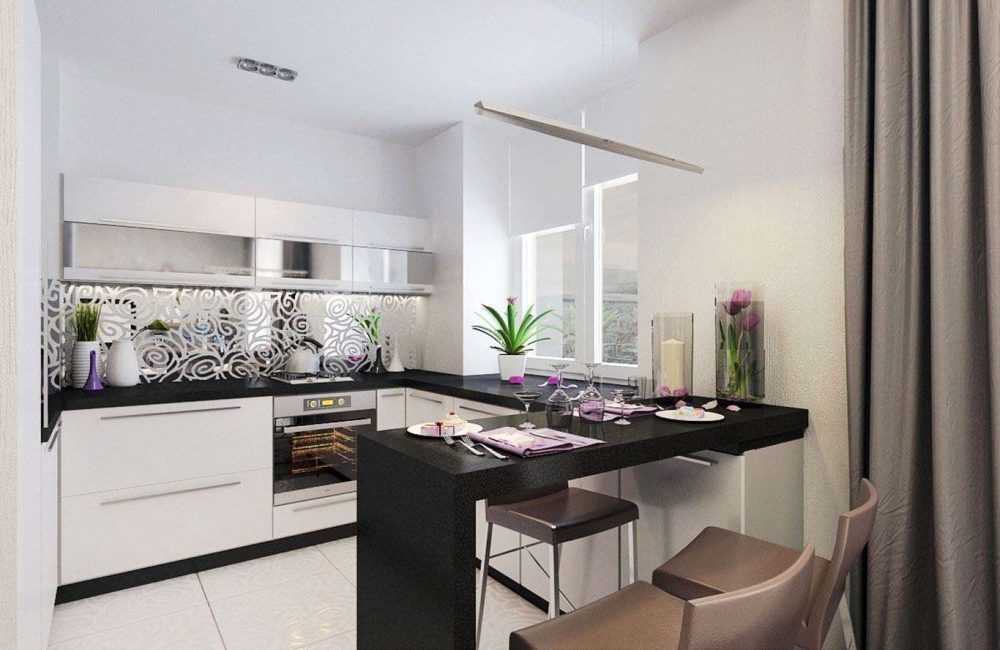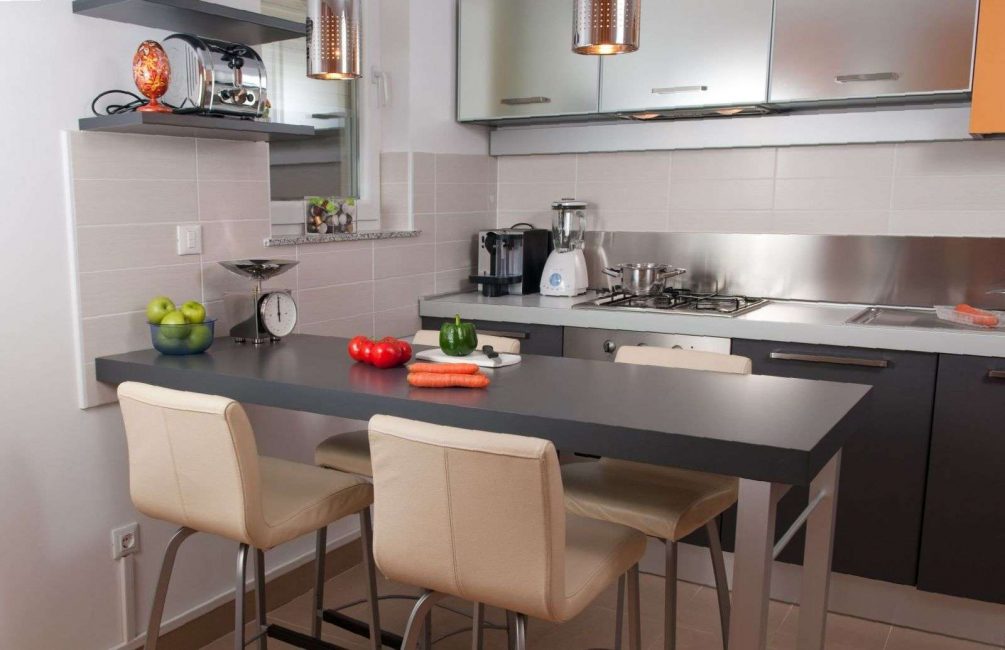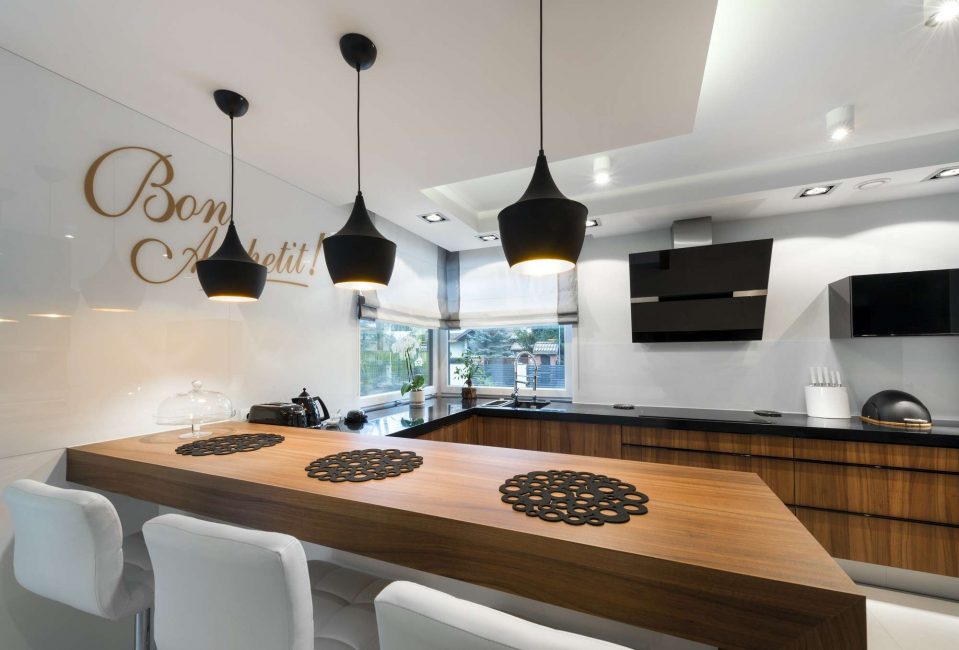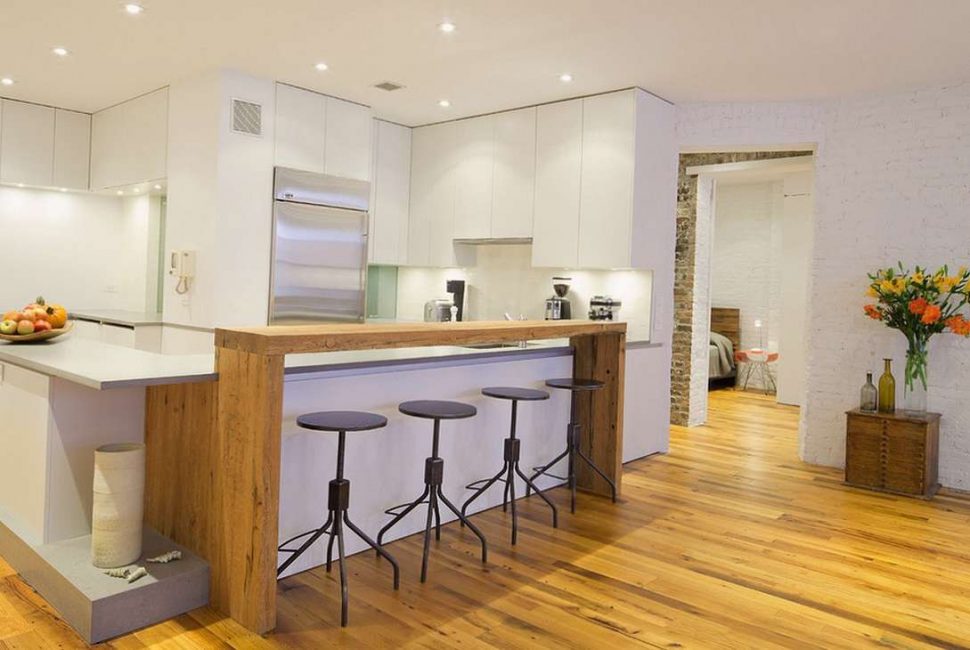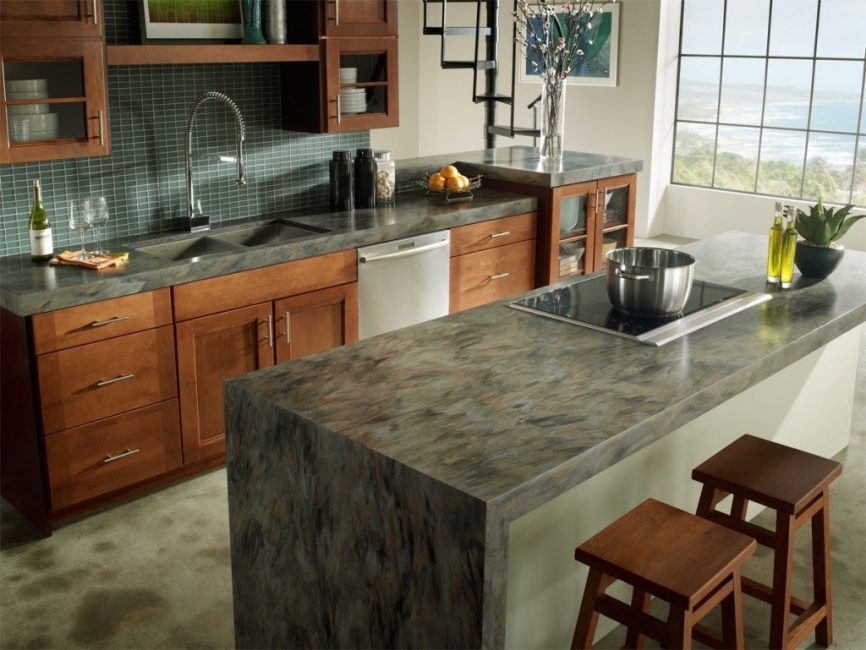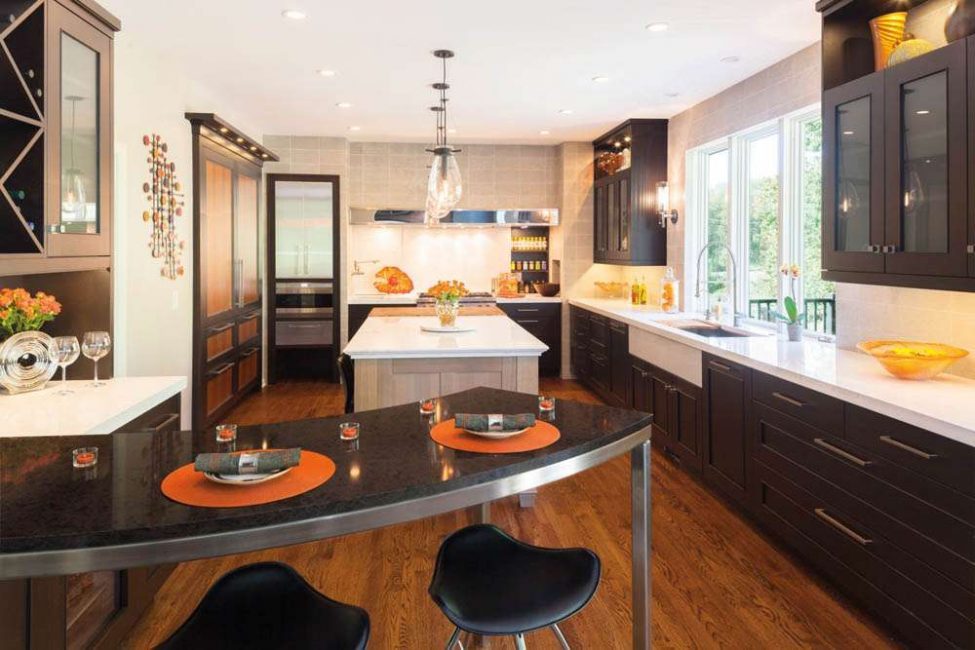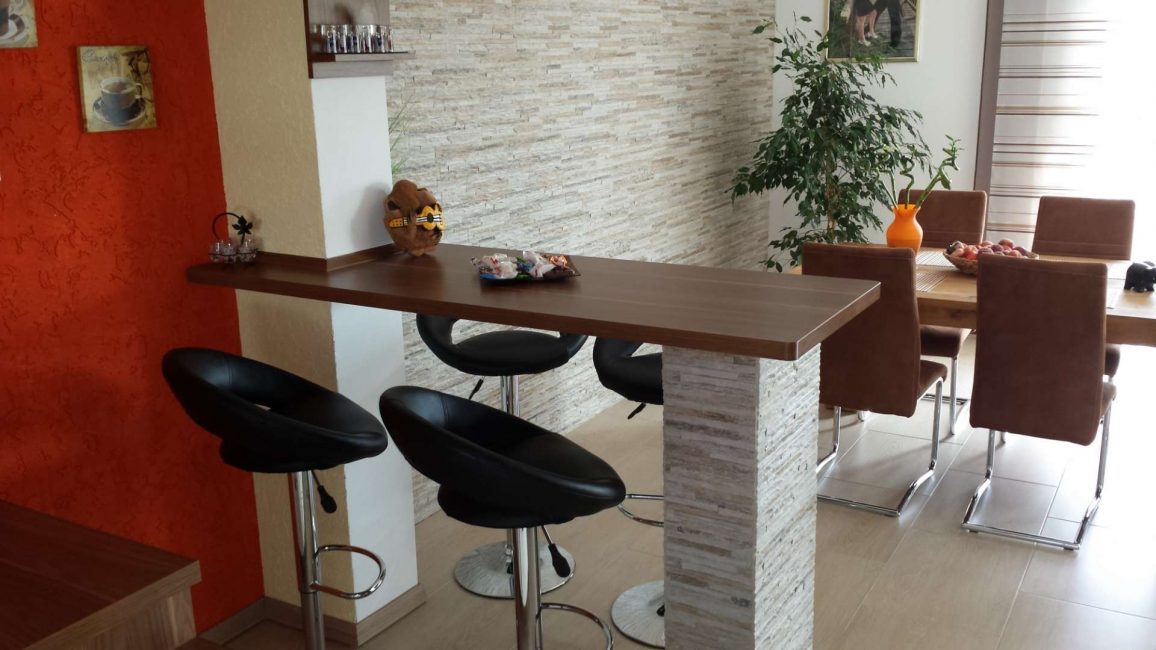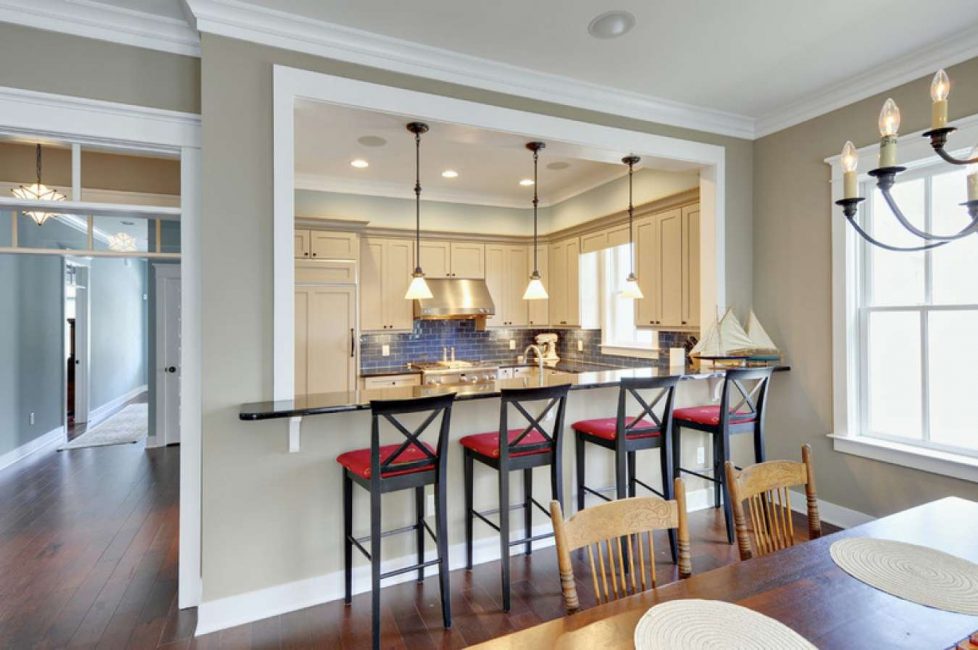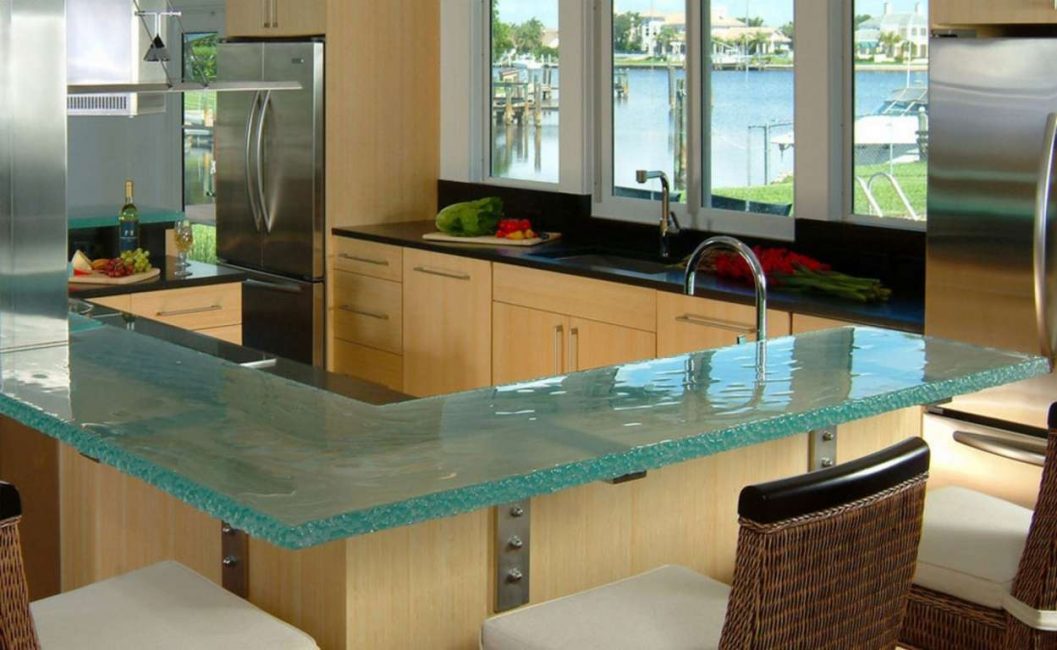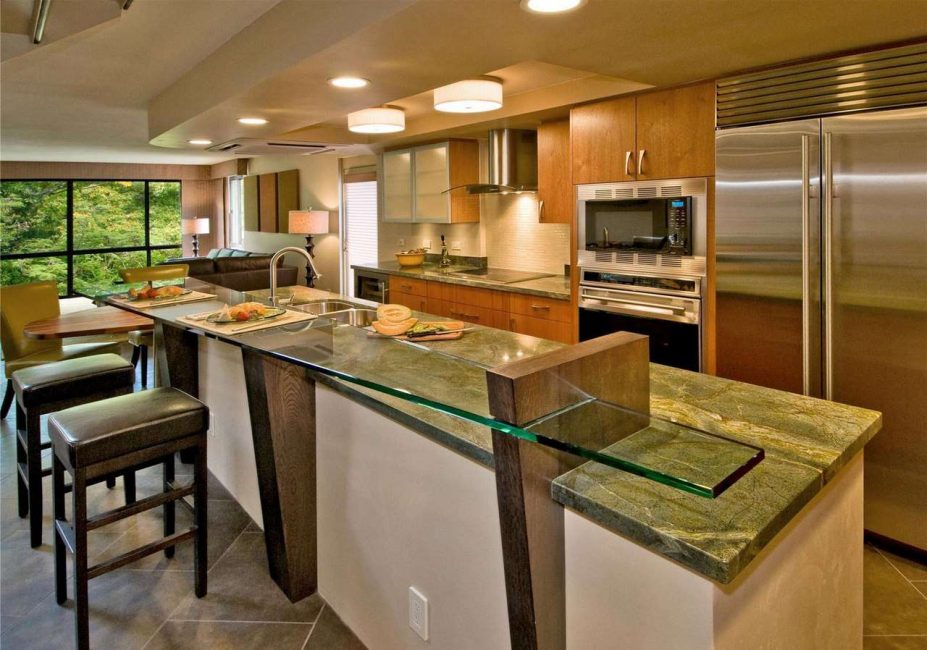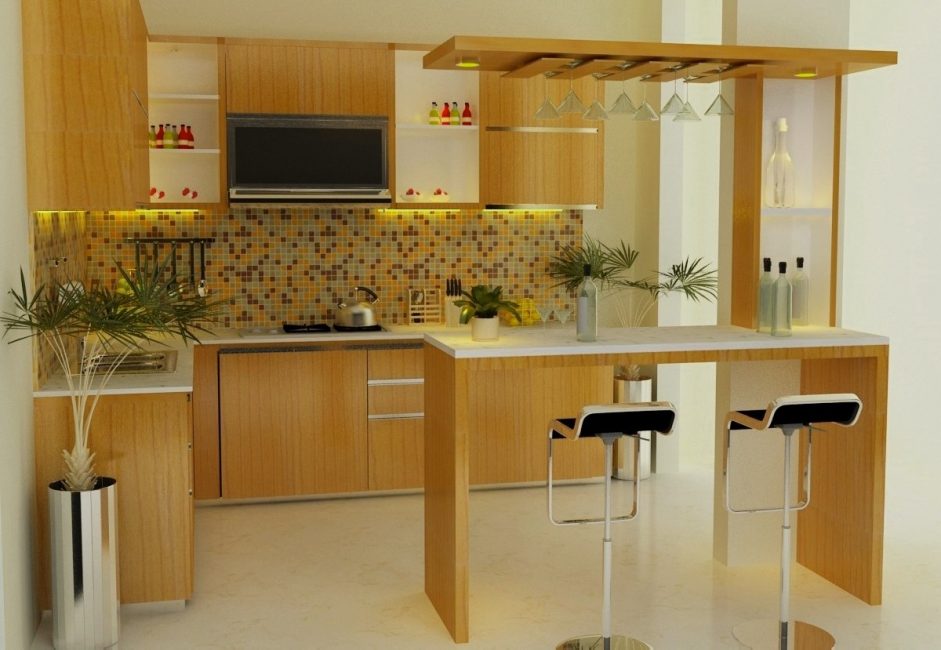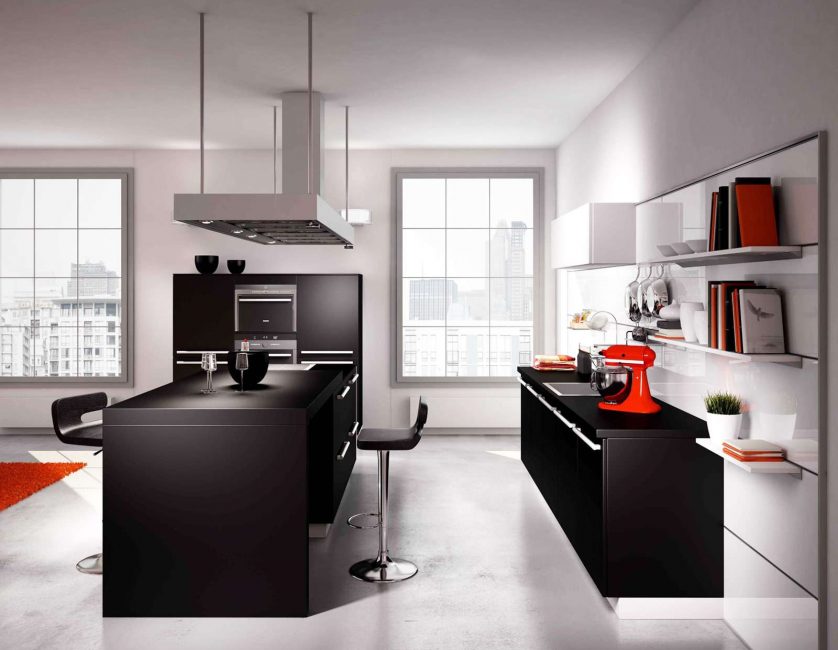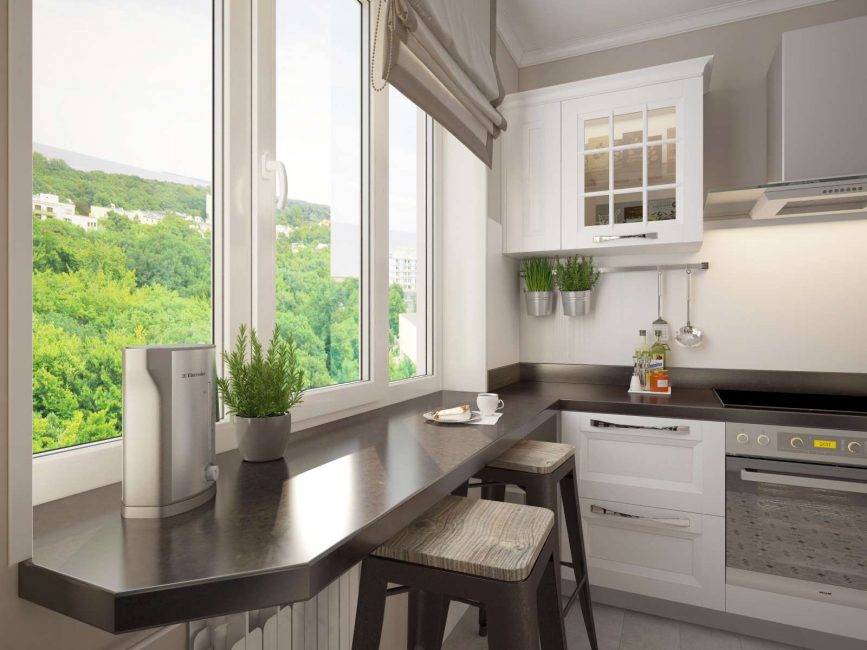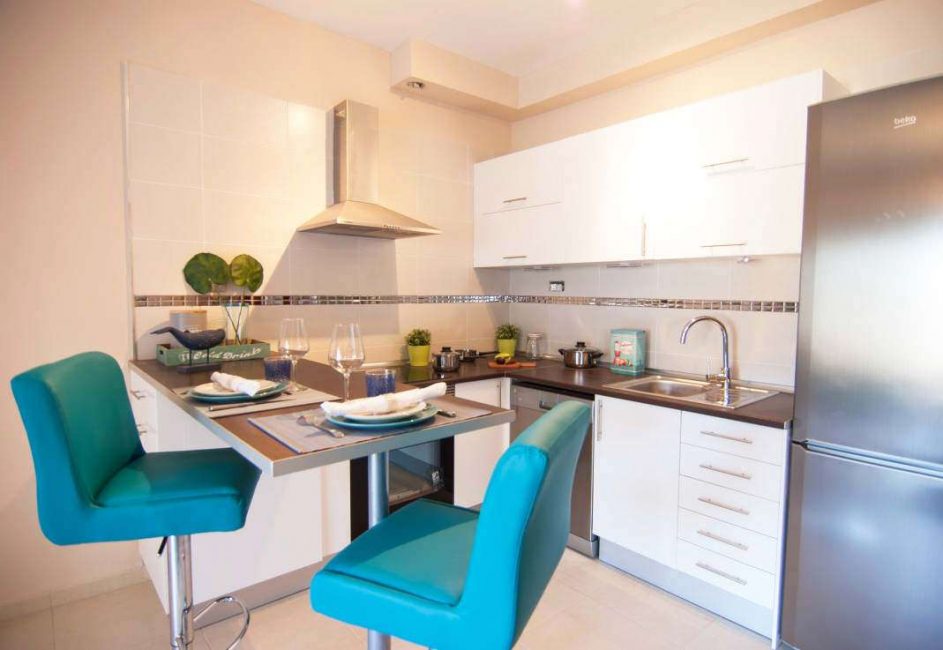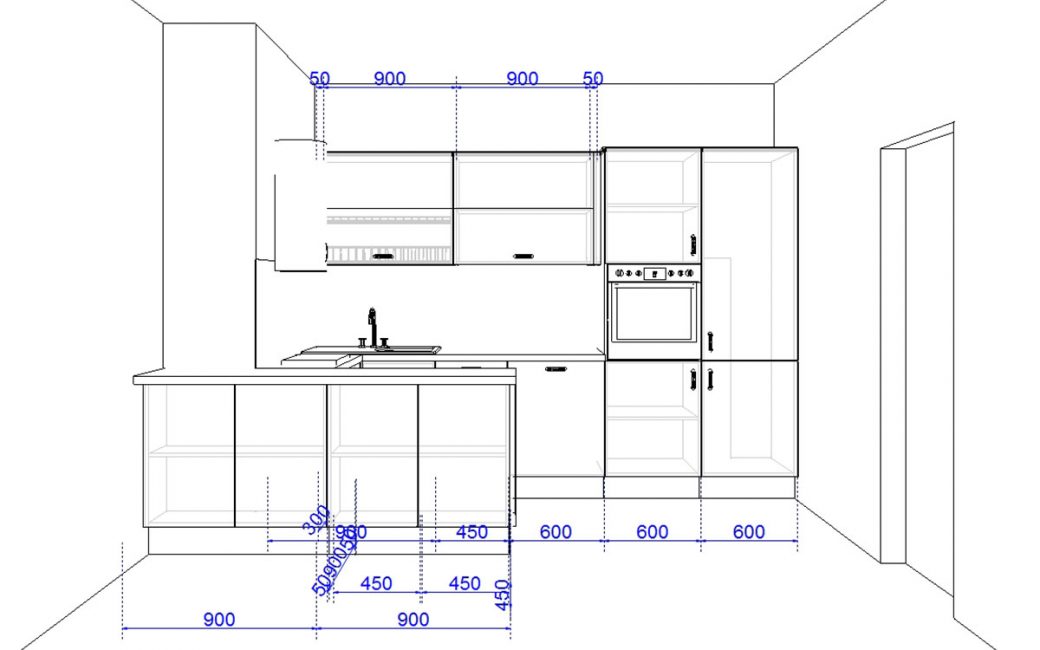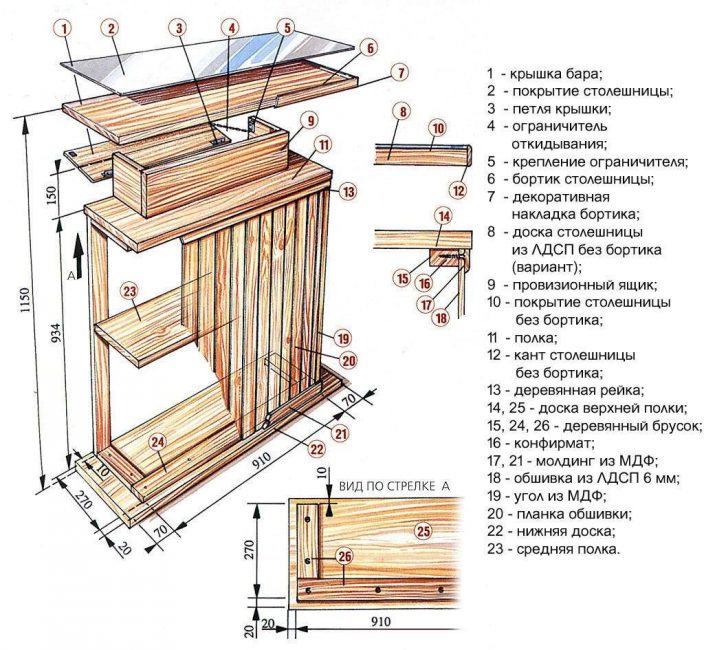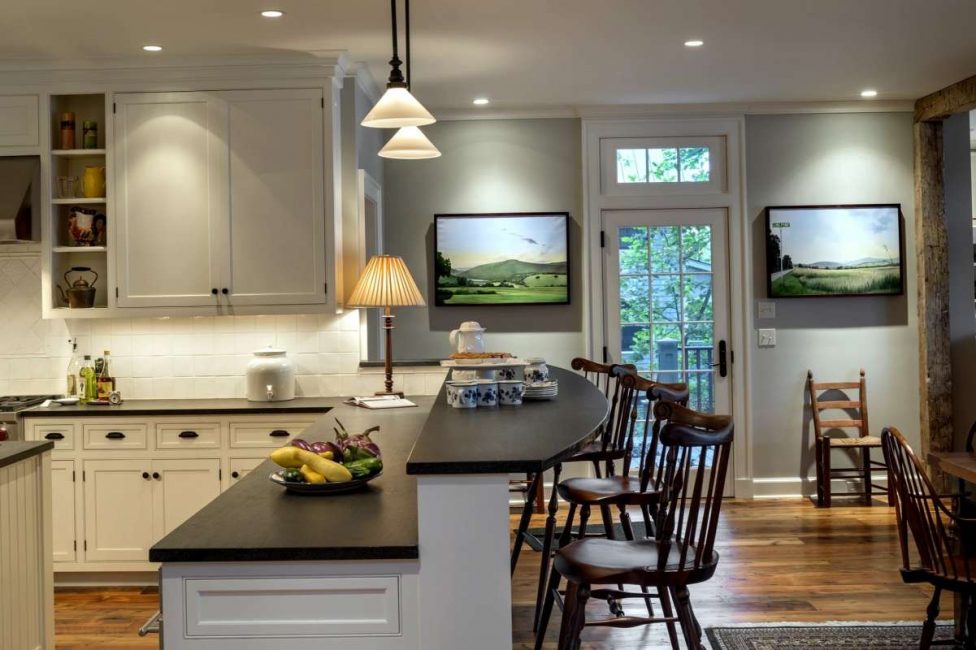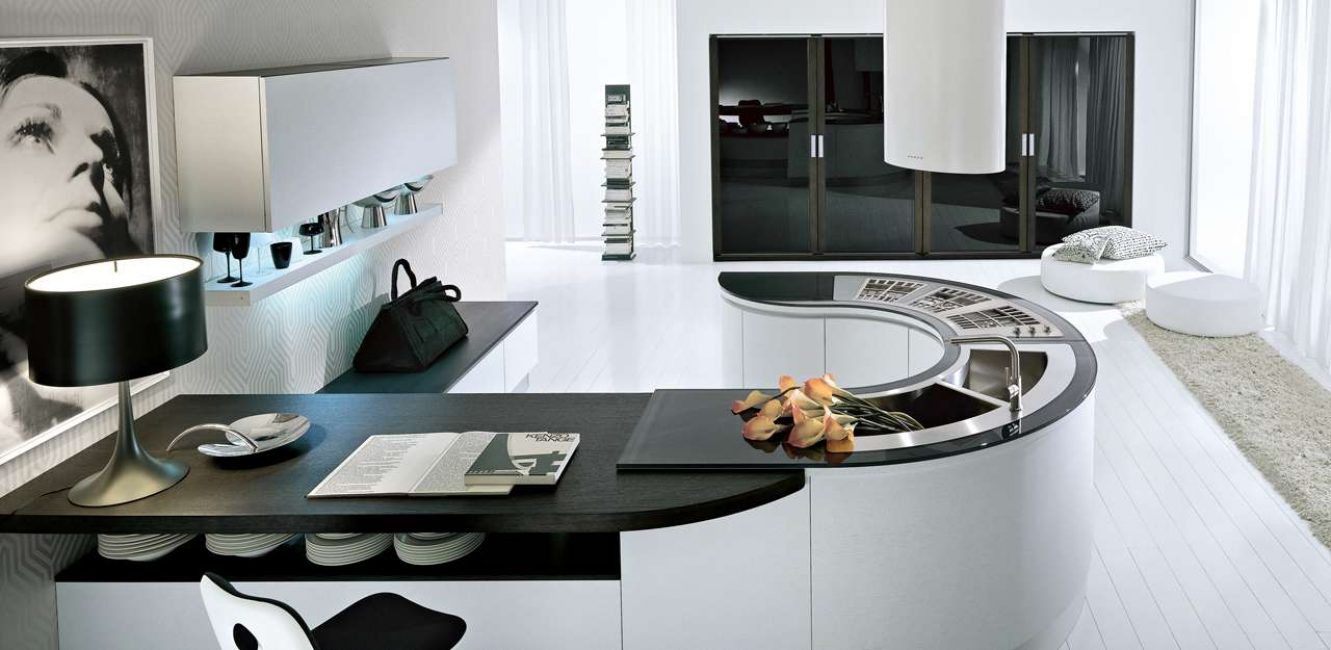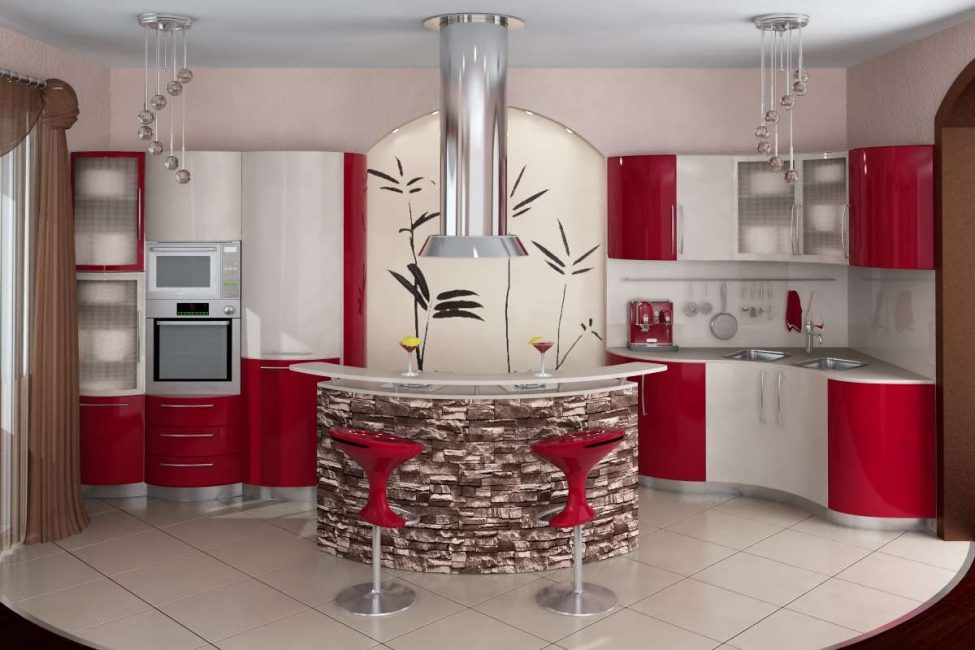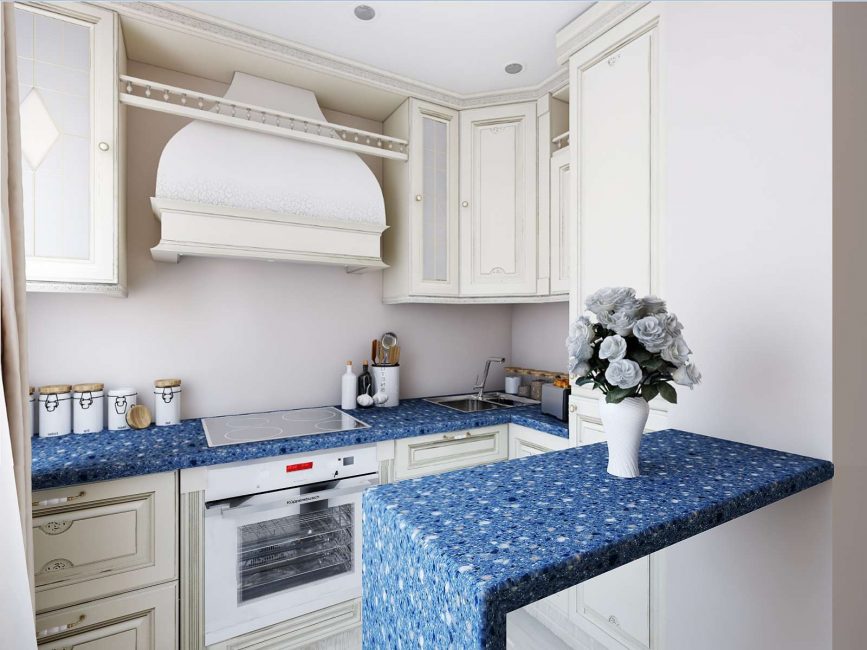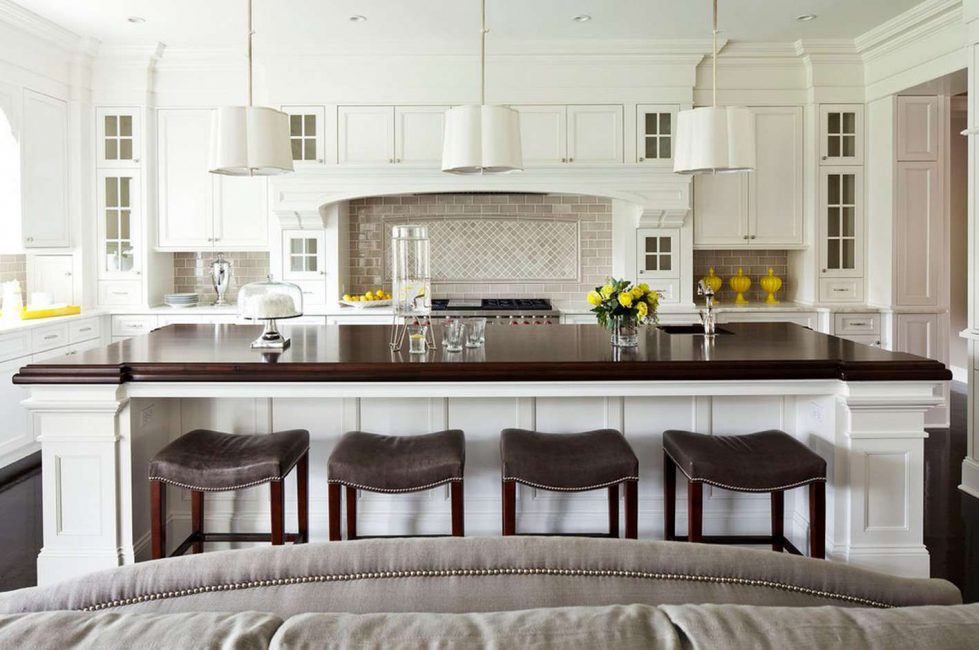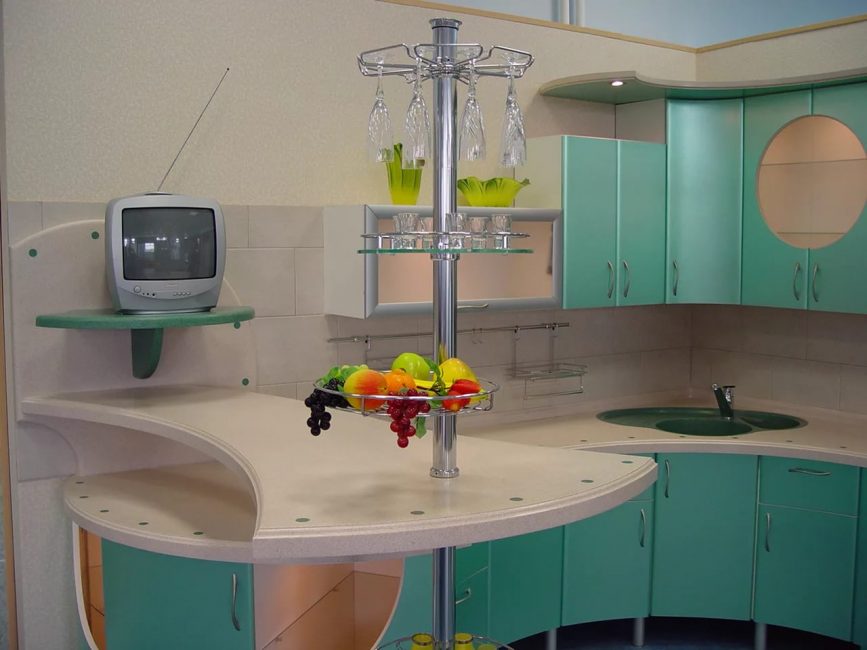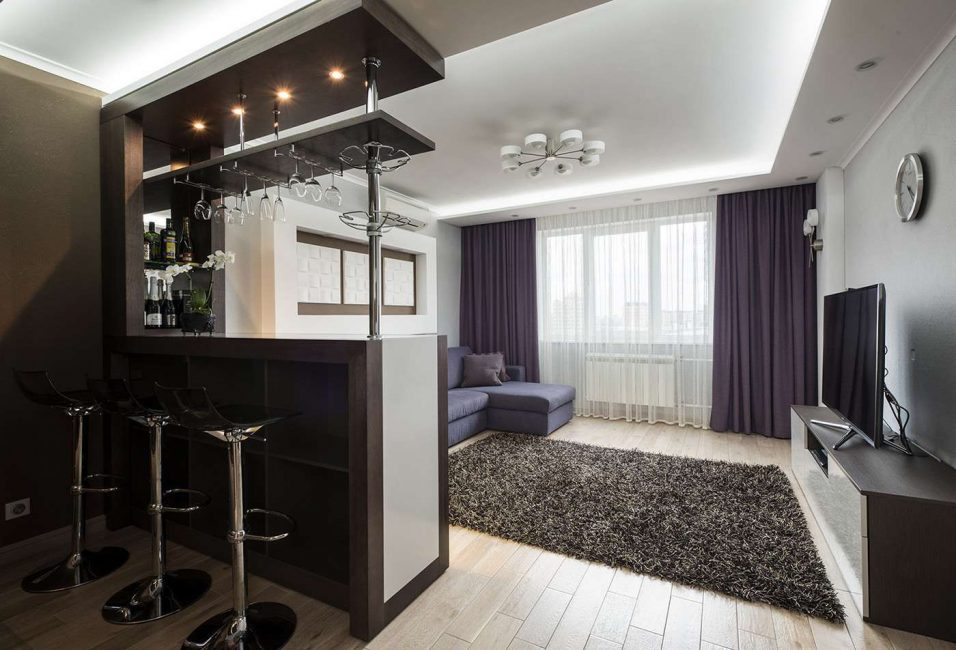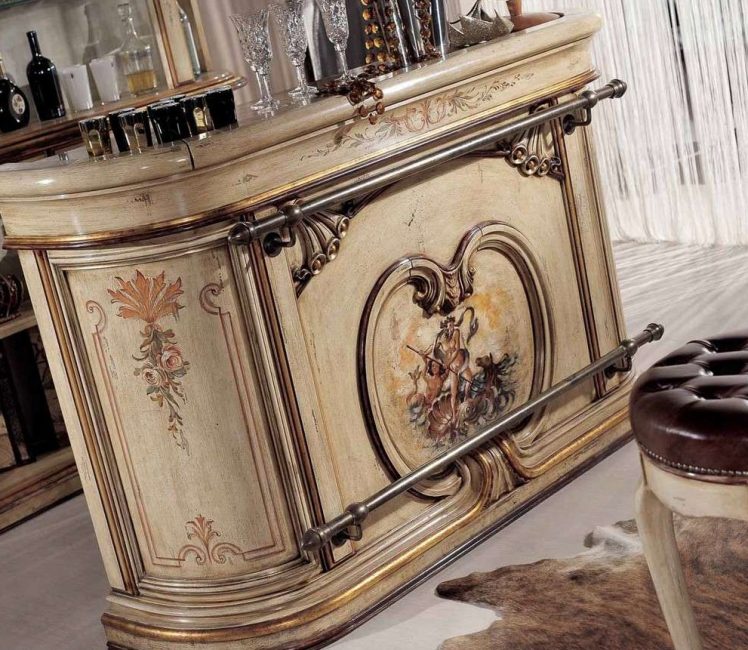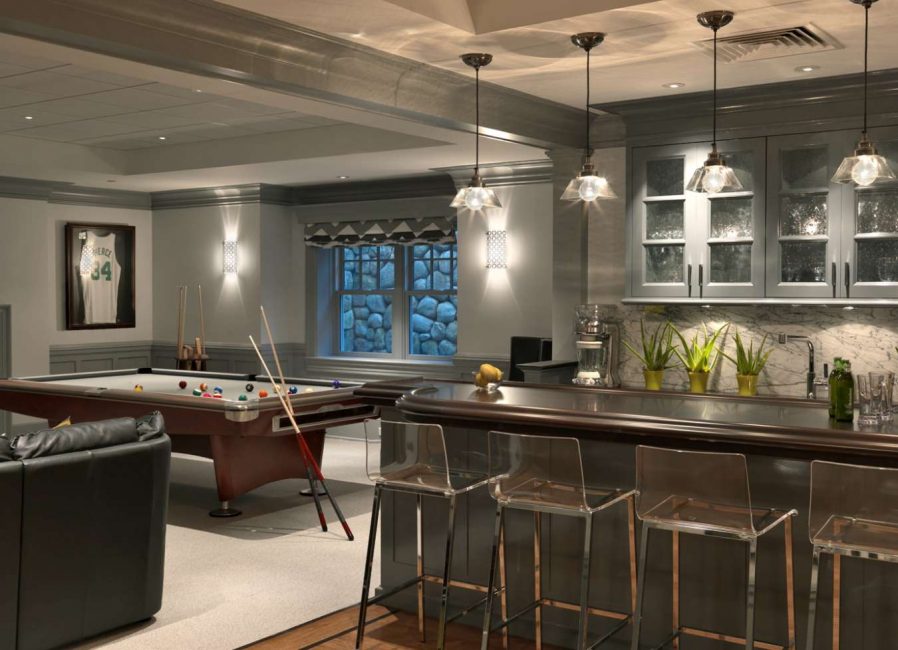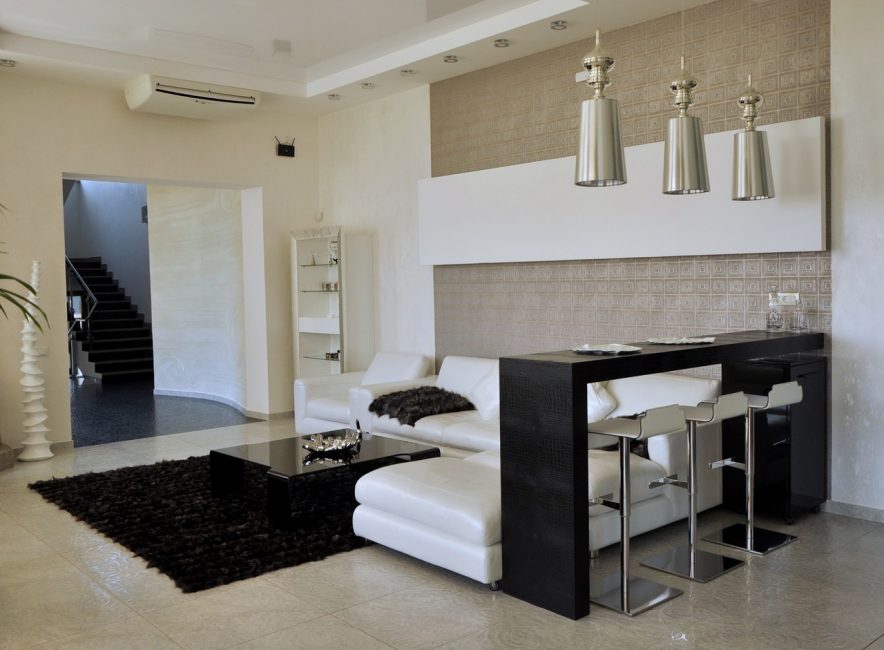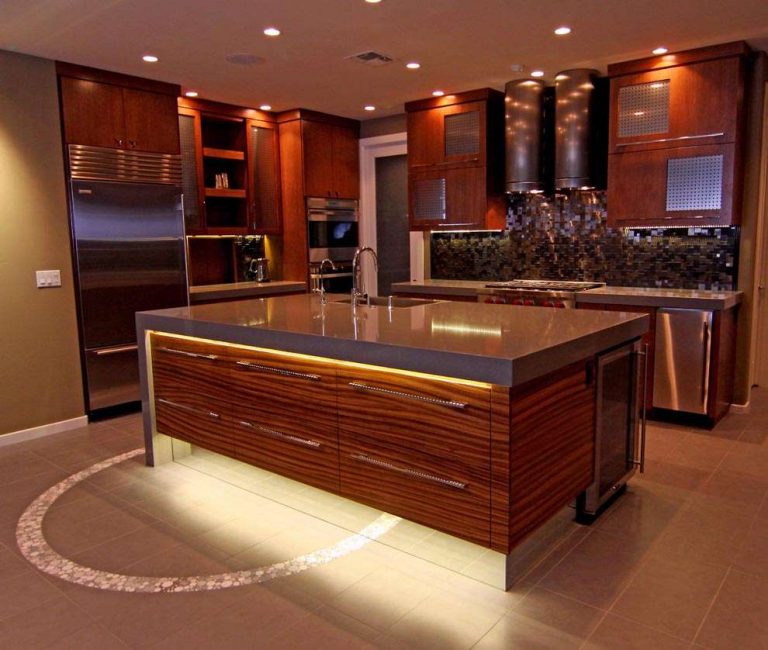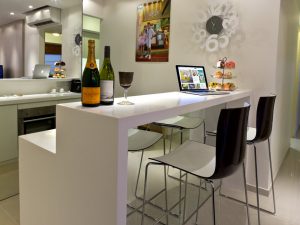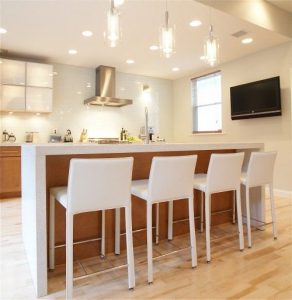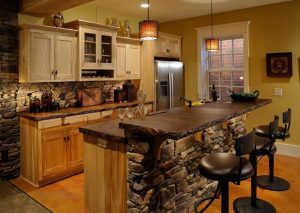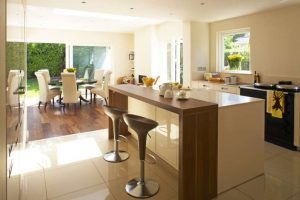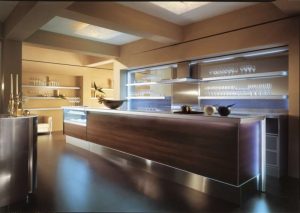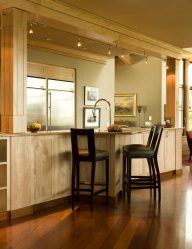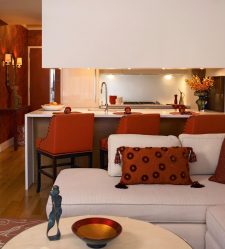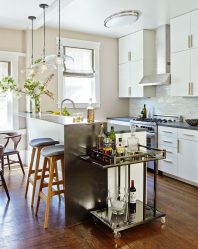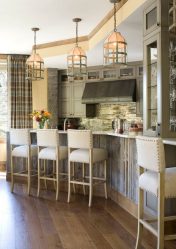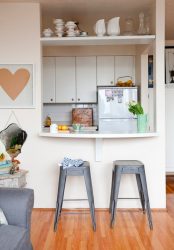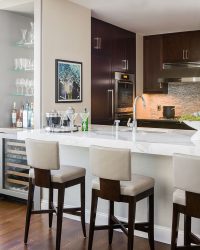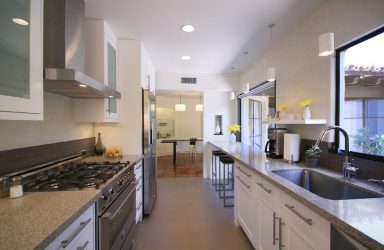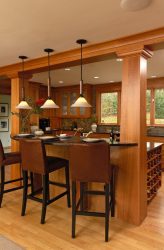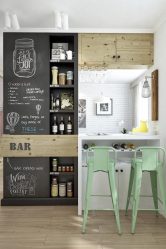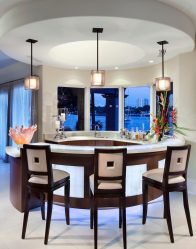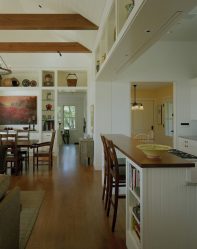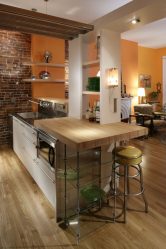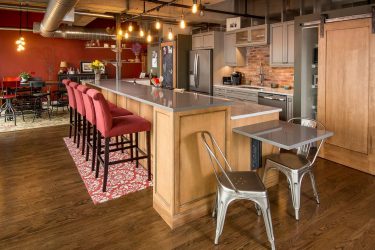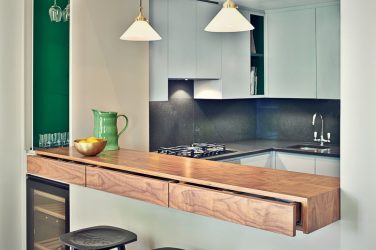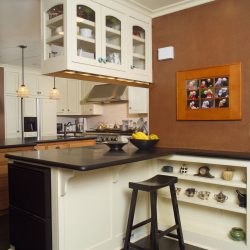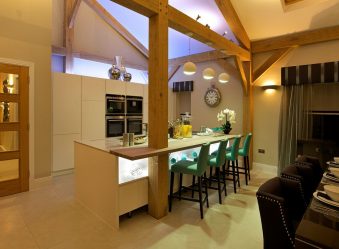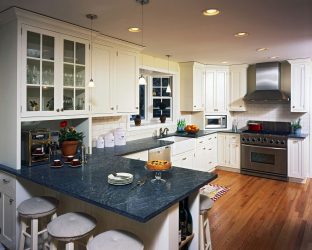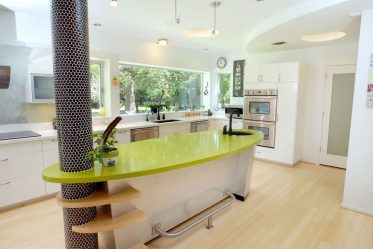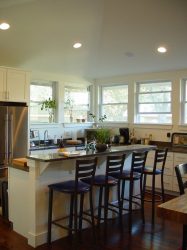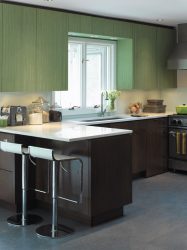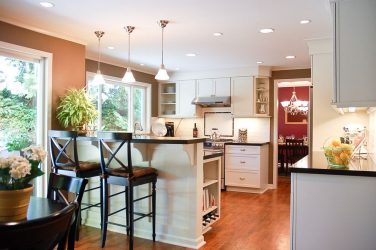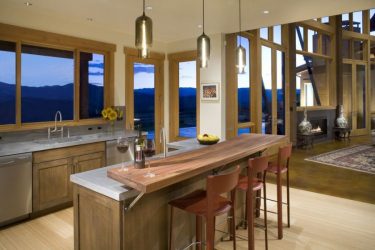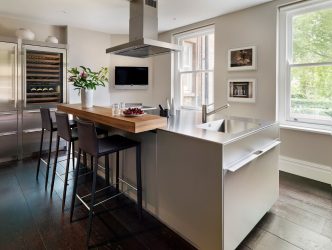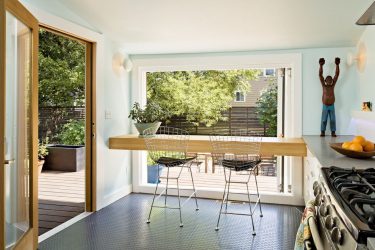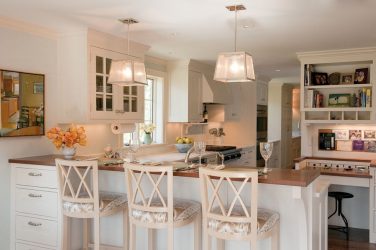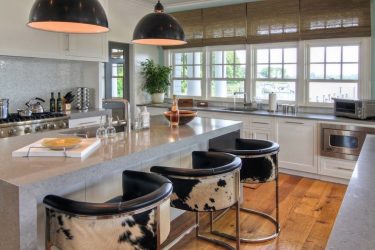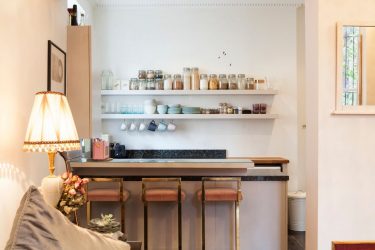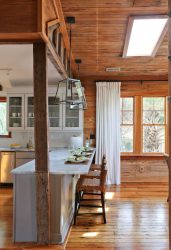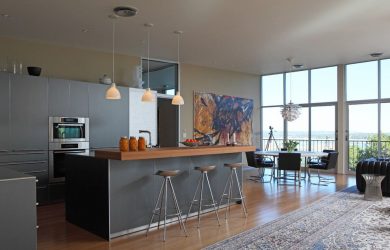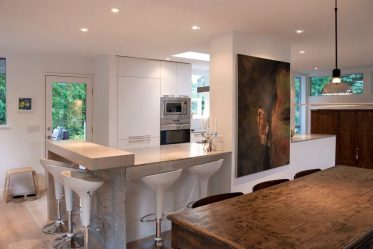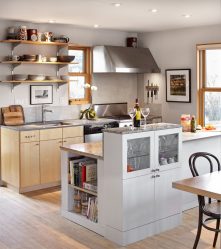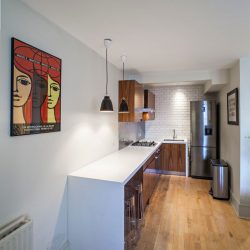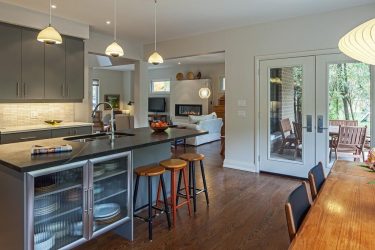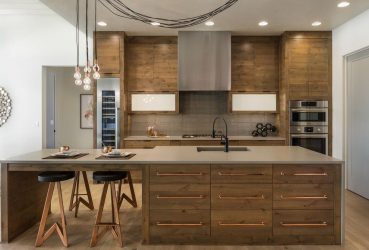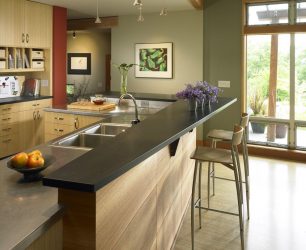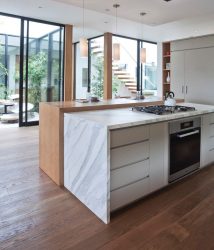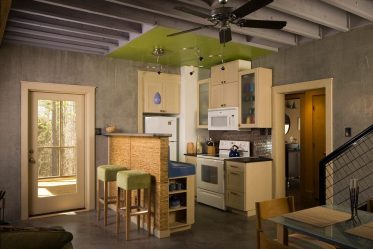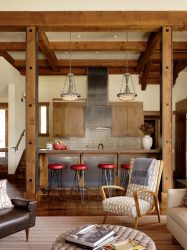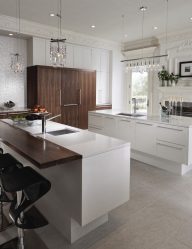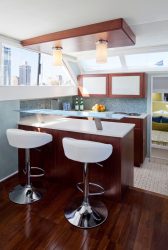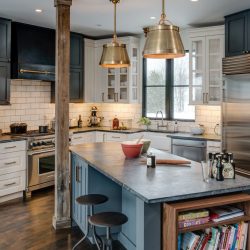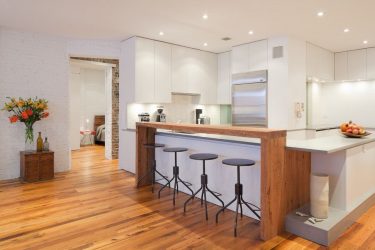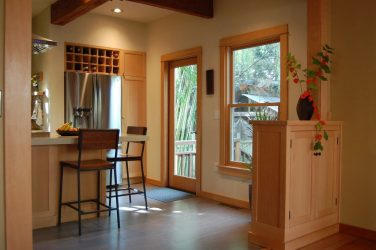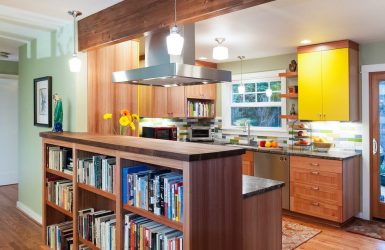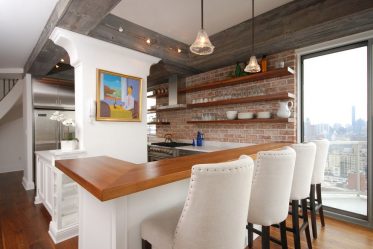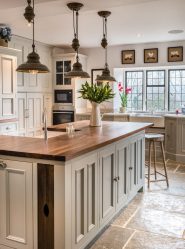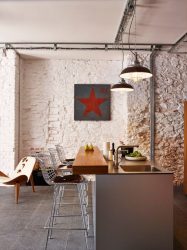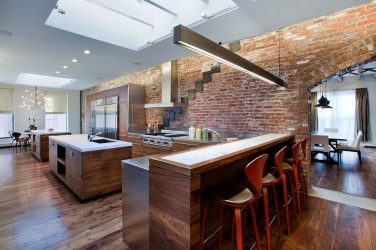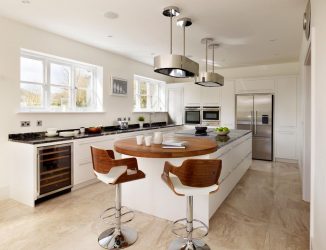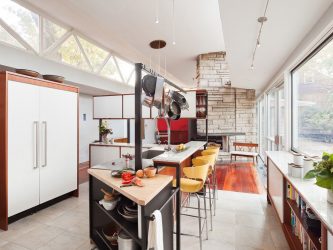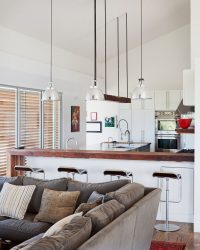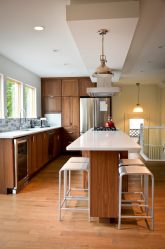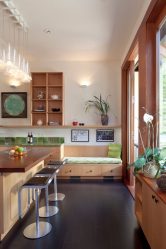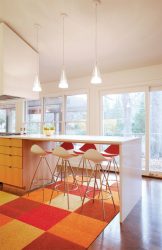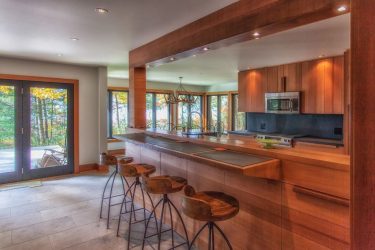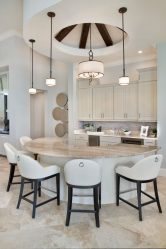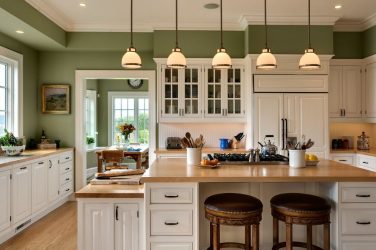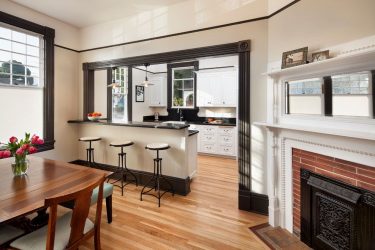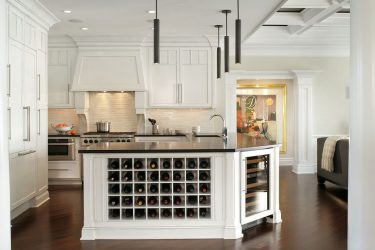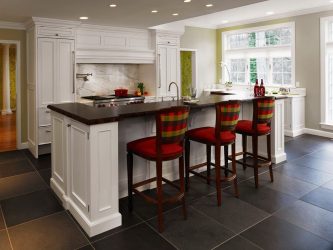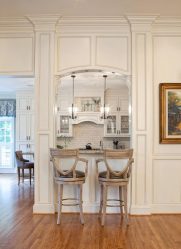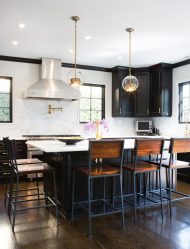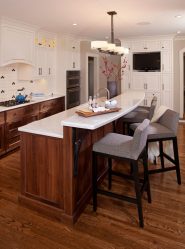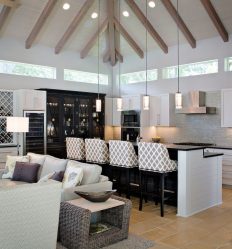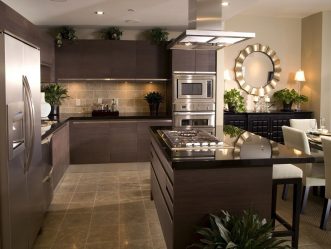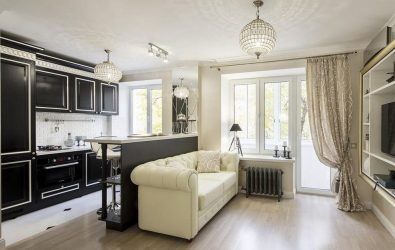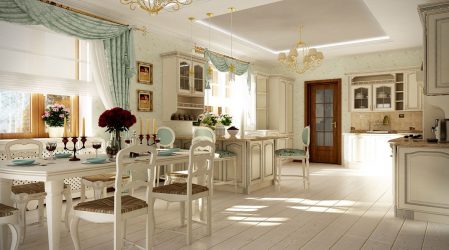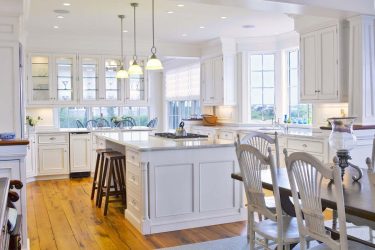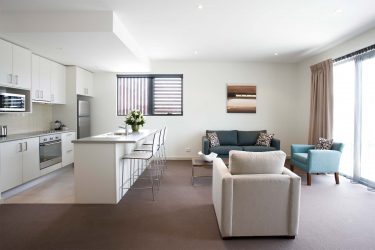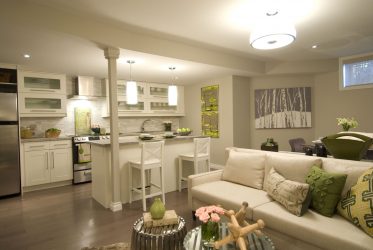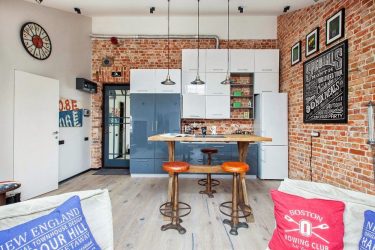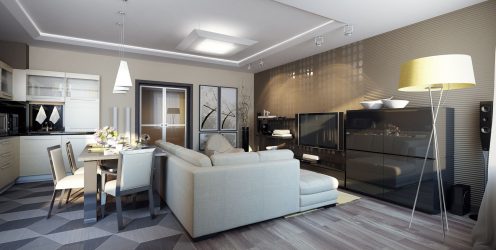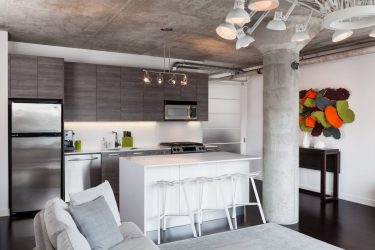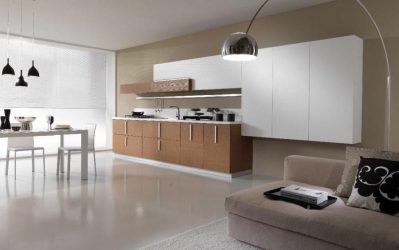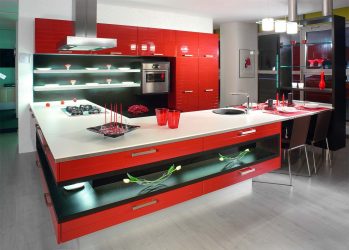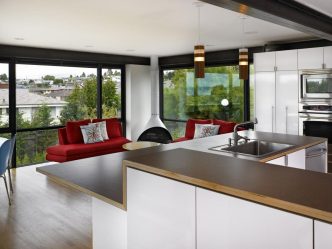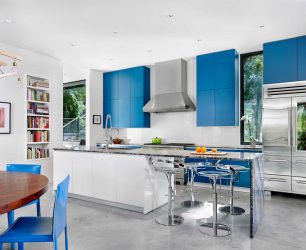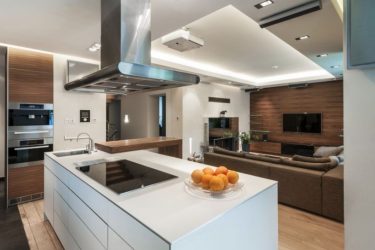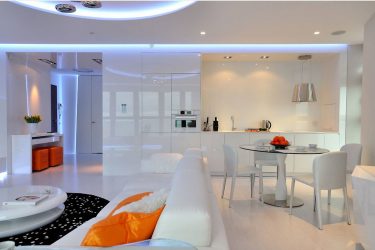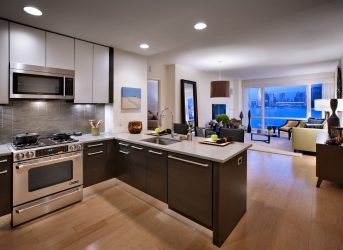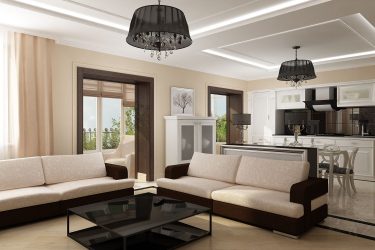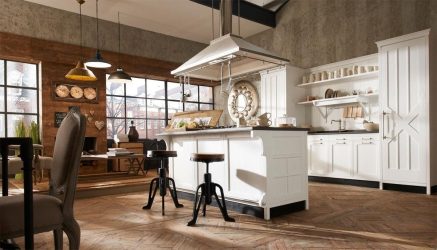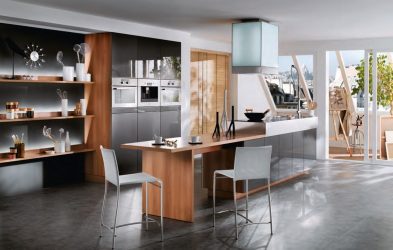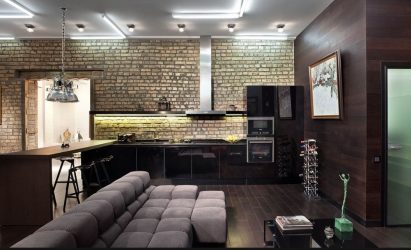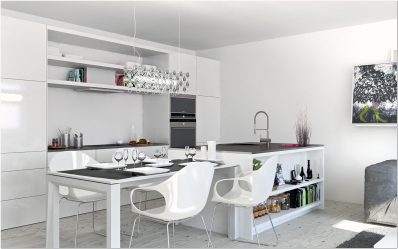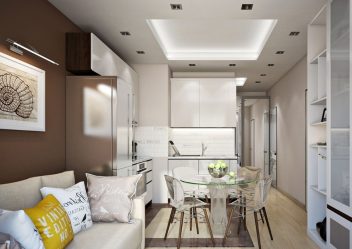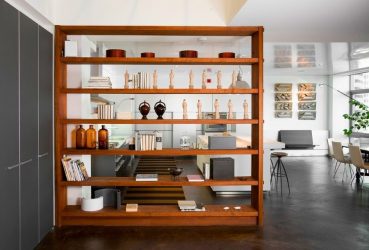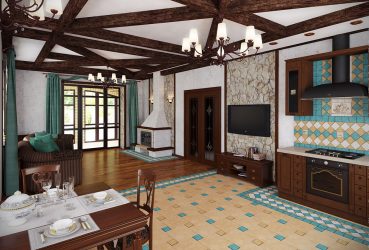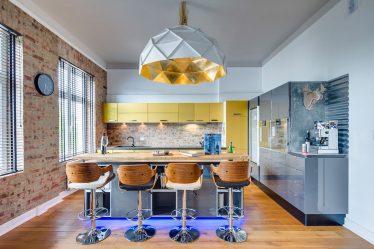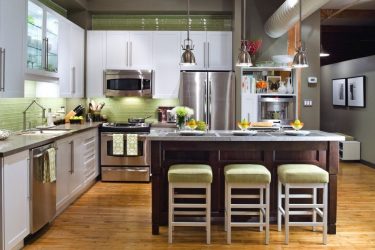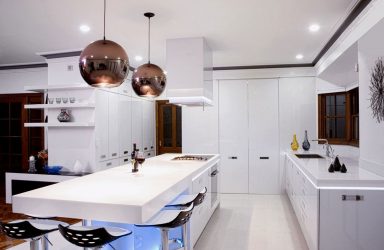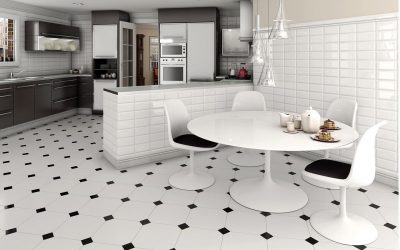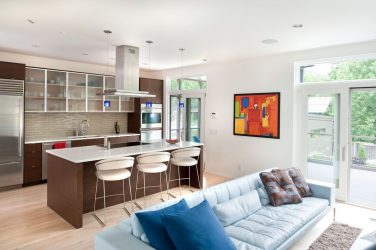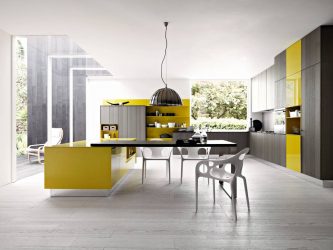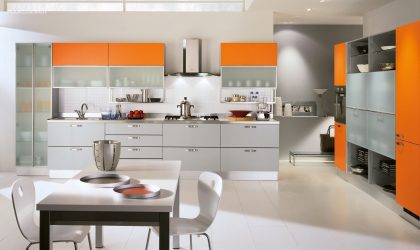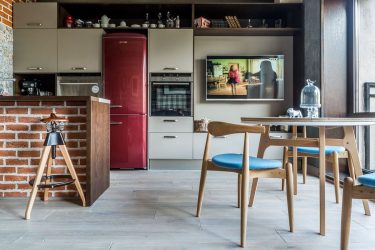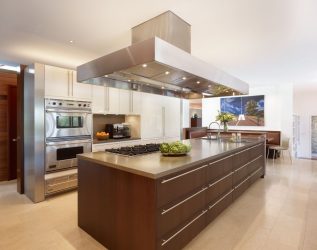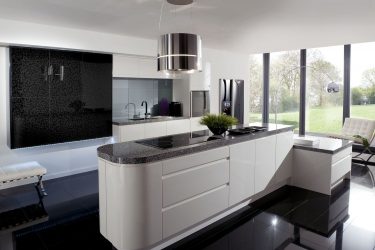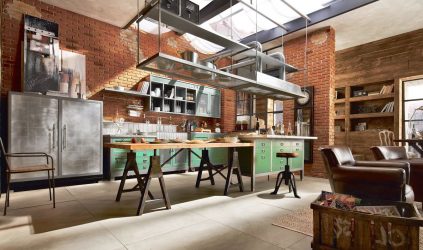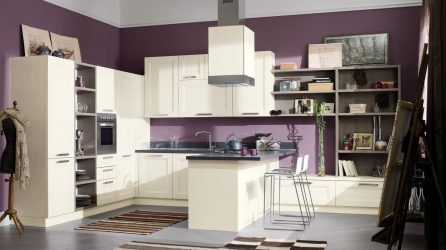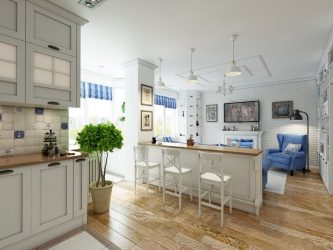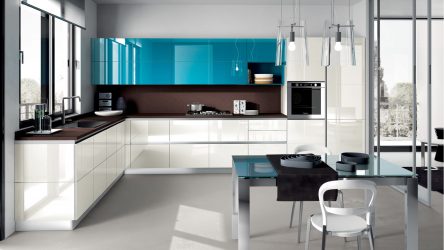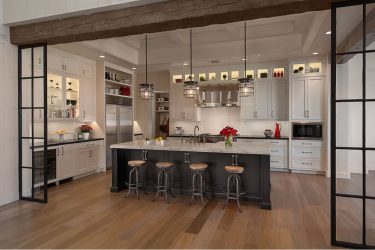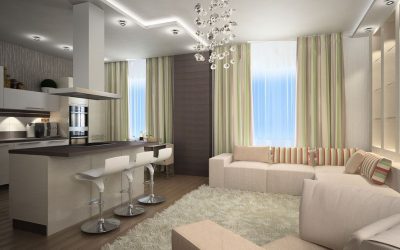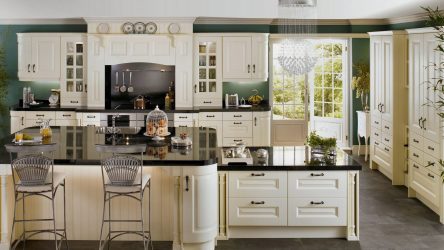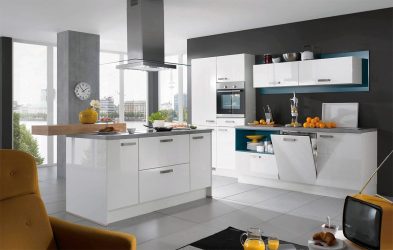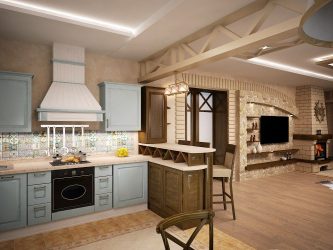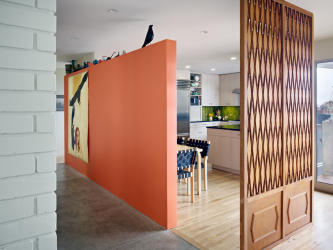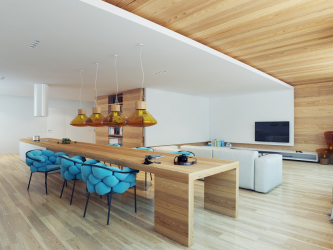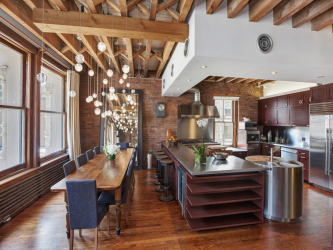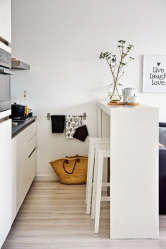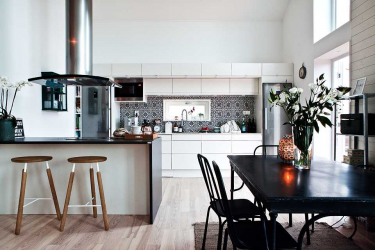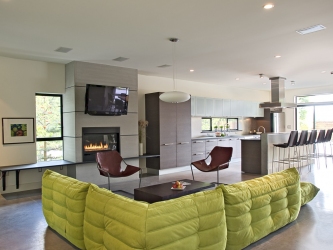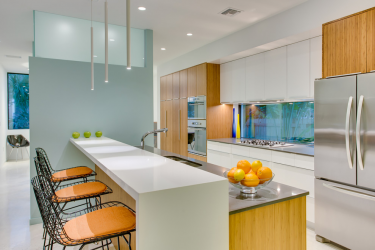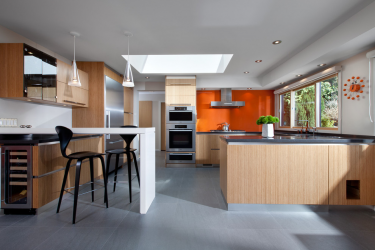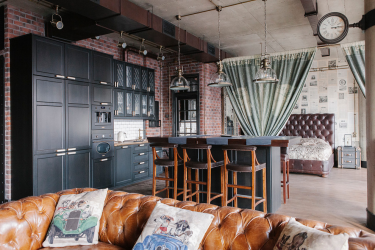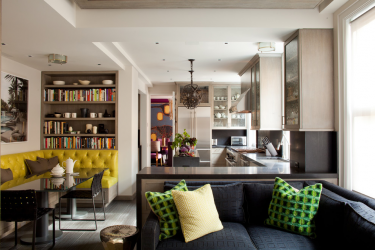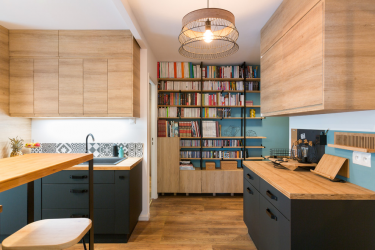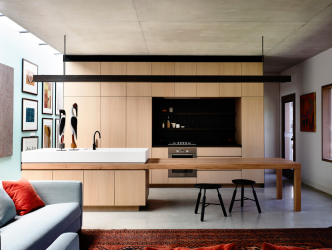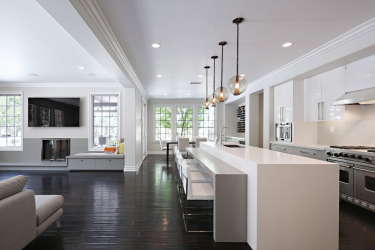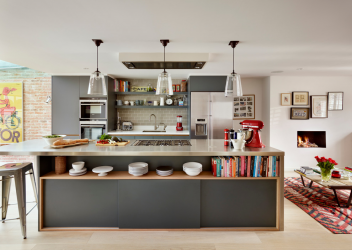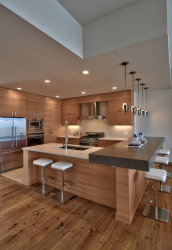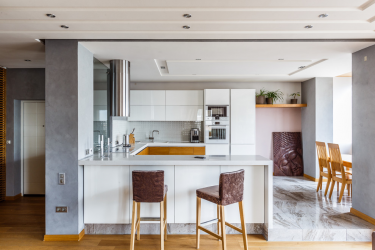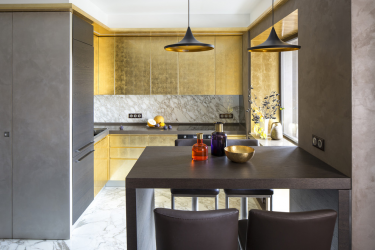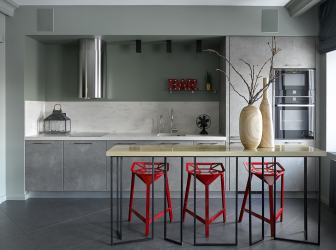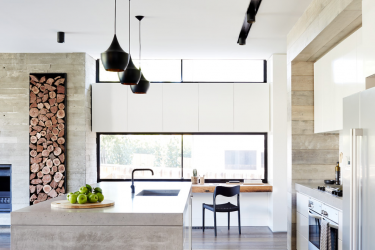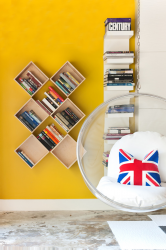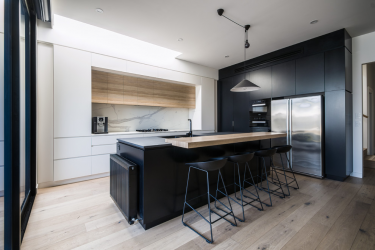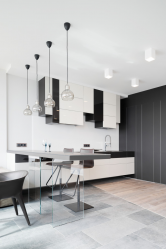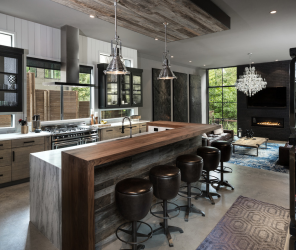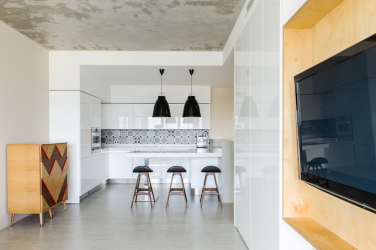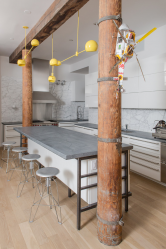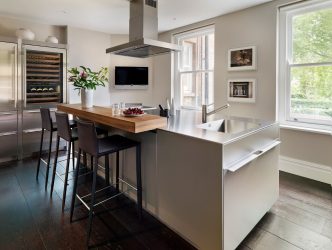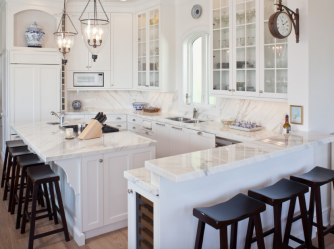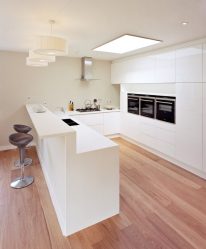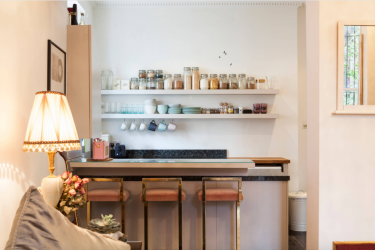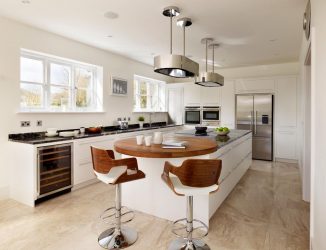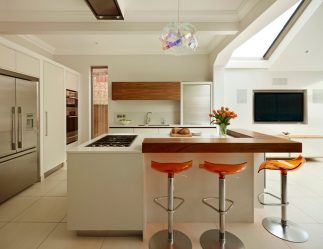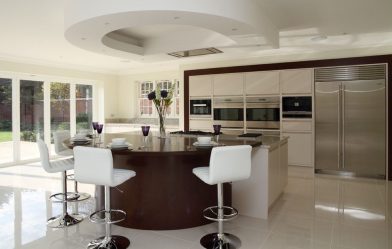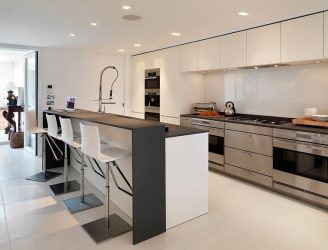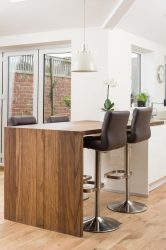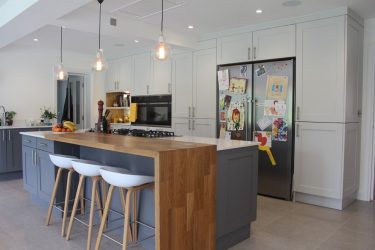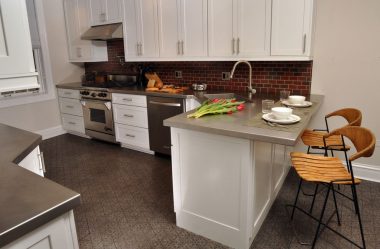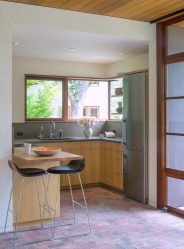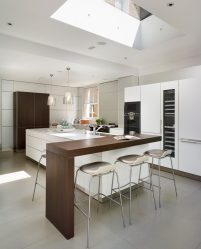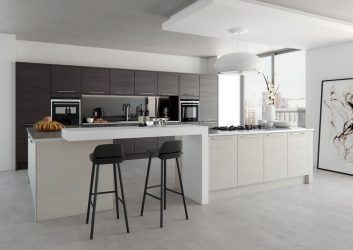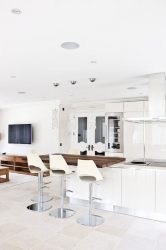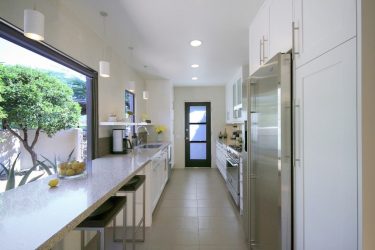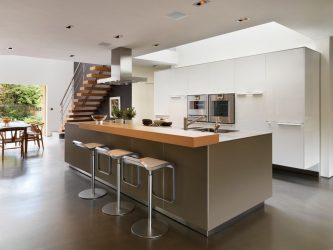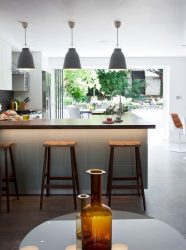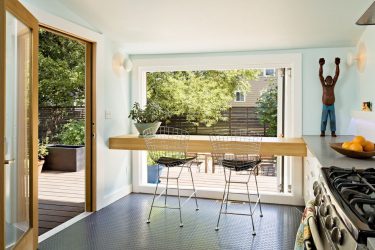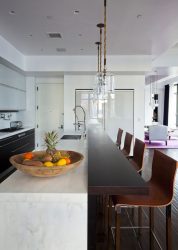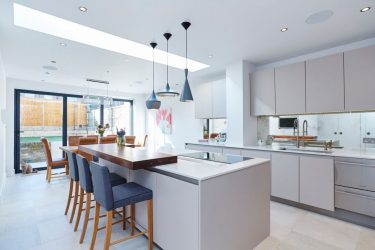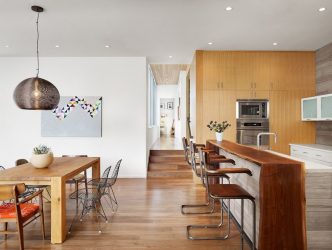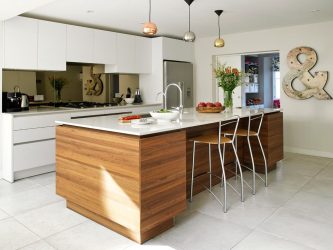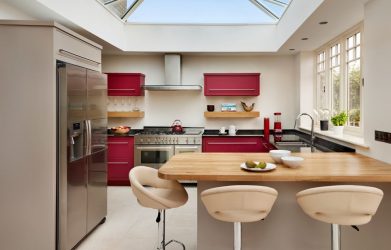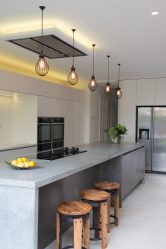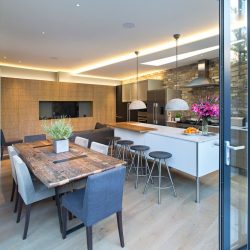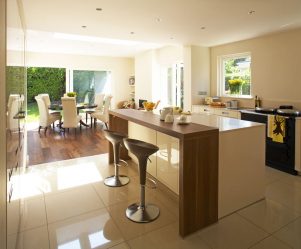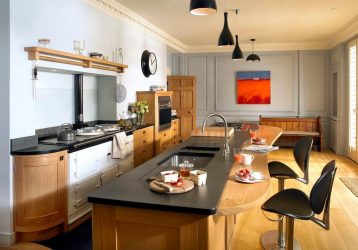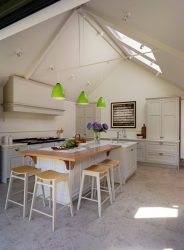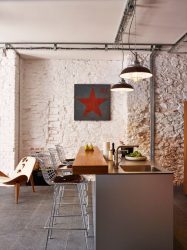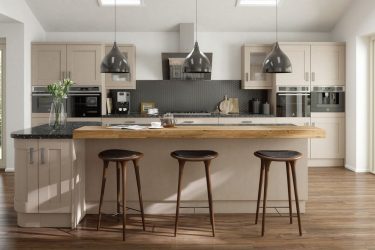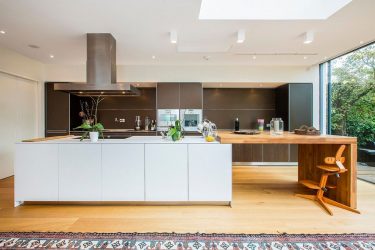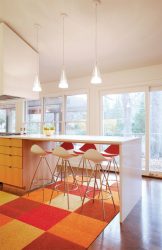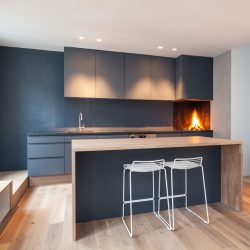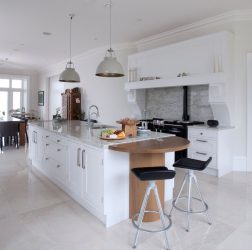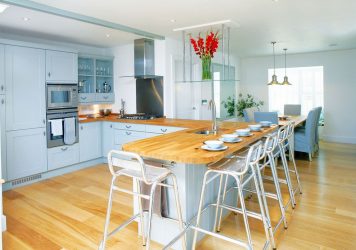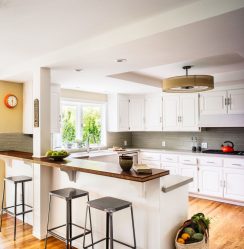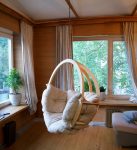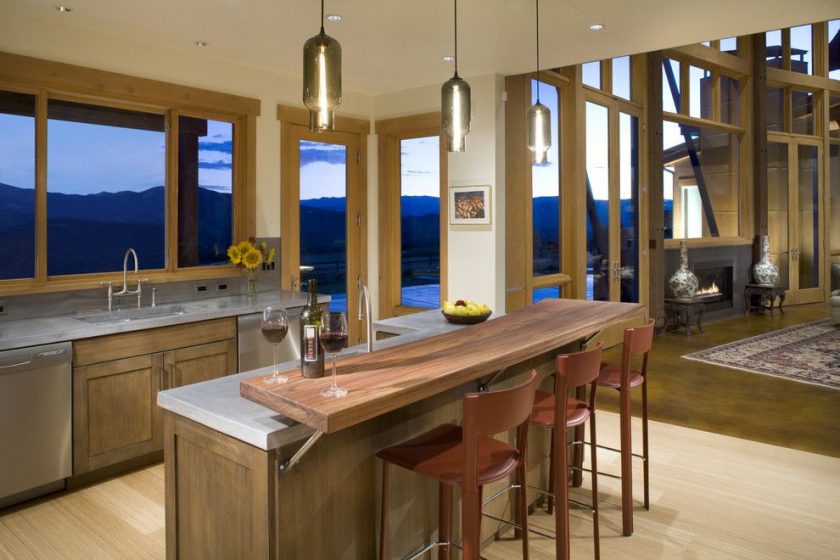
Bar counter, photo design of which will be nice to put on the Internet, can be created in any kitchen. The main thing to decide exactly what bar counter you want to complement your interior.
Content:
Her appointment can vary greatly from apartment to house. flat:
- On a little the kitchen the bar counter can perform purely practical functions - replace the dining table and provide an additional work surface on which you can cut, mix, roll dough.
- In the apartment-studios it can be a great separator and separate zone kitchens from the zone living room as obvious as possible.
- In a large apartment, where from time to time a large group of friends gathers - or a large family lives - the bar counter will become not just an extra table, but a real interior decoration, at which it is good to get together, talk, perhaps drink.
But for this to happen, you need to make an effort - you need to take into account the materials, the specific location, technical characteristics, as well as design features.
What are racks made of?
The design of any bar counter implies the presence of:
- countertopswhose material determines its appearance and performance;
- base, the material of which affects the appearance of less, but on which reliability depends.
From the combination depends on how the rack will behave at home and how it will look.
return to menu ↑Natural materials
The materials from which make countertops for bar counters, can be divided into two groups.
First - natural
Among them tree - the most classic of all possible materials. When on acrylic, tempered glass and chipboard, no one has ever heard, the tree has already been used with might and main. Its current properties, however, are different from those that were in the old days - even at the production stage, boards are impregnated with special compounds that protect them from moisture and biological irritants.
Pros:
- Beauty. Each table top is unique, noble warm shade. It gives the room comfort, well suited to classic styles.
- Reliability. Expensive wood is treated in such a way that it is not afraid of anything but fire and some mechanical damage. Can serve for decades.
Among them - natural a rock.
The material is expensive, but not without pluses:
- Beauty. Just as every wooden table top is unique, every stone is unique. Streaking, a specific color inherent in a particular species is correctly amenable, it will look gorgeous.
- Reliability. If a tree needs to be processed so that it becomes stable, nothing is afraid of a stone at all. It does not burn, does not rot, does not fade, it can be washed with aggressive agents and cleaned with metal sponges. Temperature drops will not do anything to him.
Cons of the stone - the price and weight. So that the base does not subside and does not crack under the table top, it will be necessary to carry out calculations, and in order for nothing to happen to the base plate, you will have to calculate the load on it. In addition, the stone countertop is difficult to transport and bring into the apartment.
Among them is also metal.
It is distinguished by:
- Beauty. For hi-techFor example, the metallic luster of the tabletop is simply irreplaceable. In modern style, it will also look good.
- Reliability. Stainless steel is usually bought for the kitchen - it is not sensitive to fire and moisture, it can be processed by any means, easy to clean.
Metal has two minuses - price and specific look.. The interior with him immediately begins to seem strict, a little cold. If this is not the impression that you would like to achieve, it is better to choose other options.
Synthetic materials for countertops
The second group - synthetic materials
These include:
Chipboard
The material, which consists of compressed sawdust with the addition of specific resins, which can emit harmful evaporation to humans, if the manufacturer was not conscientious. It wears out quickly, is fragile - if you hit it hard, a crack remains, if you hold it with a knife, there will be a trace. But cheap, not afraid of temperature changes. Moisture, however, can deteriorate. Handle aggressive chemistry is not recommended.
MDF
Material that is made from waste wood production - heated them, grind, mixed with resins, pressed into plates. The result is thicker and stronger than chipboard, but if you hit it, there will be a dent. In the depths of the table top parasites can start. However, less often than chipboard, it turns out to be of poor quality and harmful to health, reliable, and can serve for decades.
Plastic
Pure plastic countertops in everyday life are not to be found, they would be too fragile, but with plastic often they are faced with countertops made of chipboard and MDF. This helps protect them from moisture and give them a more interesting look. Plastic melts, if you put it hot, you can scratch it, over time it wears out, it is afraid of aggressive chemistry. But it is very diverse - any colors, any patterns. You can simulate a tree or a stone with it.
Acrylic
He is an artificial stone. Not afraid of moisture, but, unlike natural stone, it can be scratched. Does not change from temperature drops, does not fade, scratches can be reduced by polishing the damaged area. But its main advantage is not in this, but in the fact that it can be used to create any shape - round table tops, table tops that look like a blot, table tops, the surface of which fancifully curves, forming hollows where, for example, fruits can be put.Any color, pleasant to the touch smoothness - no other material provides such freedom of imagination.
Glass
The most beautiful material, which can be of any color or even in the form of stained glass. Differs in some brittleness - mechanical effects leave chips on it, during operation make sounds (for example, wet creaks when it is carried out with a rag), is afraid of aggressive chemistry and abrasive powders. It can be scratched. But it is not afraid of high temperatures (you can fearlessly put a hot frying pan on it), high humidity, biological threats, dirt. It gives the interior a wonderful cool airiness. It has a high price.
Synthetic materials are in no way inferior to natural (if we are not talking about the lower price segment of the particle board), because you should choose only on the technical characteristics and aesthetic preferences.
Substrate Materials
The base of the bar should be in harmony with the countertop, and with the rest of the kitchen. You can make it from different materials:
- Chipboard and MDF. They are usually combined with a tabletop from the same material. They are cheap, look good, because they are usually made under natural wood. The only drawback is fragile, if someone inadvertently kicks such a foundation, an inaccurate dent will remain on it.
- Drywall. Often used when a person wants to make a stand with his own hands. One hundred worktops can be combined from virtually anything, the main thing is to choose a good color and texture. It is a metal frame, sheathed with sheets of drywall. Mechanical damage is also not stable - the dent will remain, but there are many design options.
- Brick. The material is heavy, requiring some dexterity in circulation, fits well with hi-tech and minimalism, but is very limited in expressive means. The color of the brick is always about the same, in addition to finish it just does not make sense - to put chipboard or drywall easier. But completely insensitive to damage and can stand in the kitchen for a dozen years.
- Tree. Real wood is used only if the naturalness of the material is fundamental. The properties are not much different from the rest, only in appearance.
- Metal. A solid metal base will be too heavy, because the metal is usually used to make a round pipe on which one edge of the table top can rest. Used in minimalism and hi-tech, or where the owner wants the rack to look classically.
- Partition. In some apartments, the partition between the living room and the kitchen is destroyed to get a single room that can be zoned. In this case, the tabletop can be placed on the remnants of such a partition - the result will be very reliable, most likely it will not be possible to damage it.
Types of racks
The material from which the rack is made determines how long it will last and how it will look. But how it will fit into the design and what practical needs it will answer - it depends on its location in the kitchen.
return to menu ↑Stationary
Stationary racks do not move at all - they stand in the place where they were put once, for decades. They are different:
- «Isle". This is a big stand that stands apart from the rest. of furniturelike a dining table.Usually “islands” are used in large kitchens, where there is a lot of space and there is where to turn.
- «Peninsula". It is not located separately, but is a continuation of the rest of the kitchen set - a short crossbar in the letter “g”. Also for large kitchens, otherwise the rack itself will turn out very small.
- The wall. This stand is located against the wall and is suitable for small apartments, since it takes up little space - even less than a regular dining table, due to its small width.
- Window sill. In fact, the window sill itself is a ready-made bar counter, just expanding it a little and putting chairs to it. Suitable for a small kitchen in which there is no place to turn around at all - will be an excellent substitute for a bulky dining table.
- In the partition. In the apartment, where the kitchen and living room combine, destroying the interior partition, you can choose the original version of the rack, destroying the partition not to the end. Then the tabletop can be placed directly on it, and the upper part of the wall can either be completely demolished or left so that the stand is turned into a kind of “window”.
Stationary racks are a good solution, but if you like change (or if you have a very small apartment, where any piece of space is important), then transformer racks are more suitable.
return to menu ↑Transformer racks
Among them:
- Folding. Attached either to the wall or to the kitchen. In the folded position, they are completely invisible, but if need be, it is enough to pull the protrusion so that the stand leans back and you can safely use it.
- Retractable. Fasten usually only to the headset. If you need, you pull the ledge - and the rack rolls out so that you can use it.
- On wheels. Such racks are rare because they rarely need. It makes sense only if you need free space in the kitchen, and you are going to push the rack to the wall - or you want to transport it from time to time from the kitchen to the room and back. Usually they are made of metal, light enough that not the strongest person could roll too.
Final touches
By this time you can already roughly imagine what materials and construction you need a stand for. It remains only to add a few details to the image so that it becomes complete.
return to menu ↑Dimensions
- Height. At the classic bar counter is a meter with fifteen centimeters. Such a height is perfect for the “island” and for zoning - it will qualitatively separate one zone from another. But you need special high chairs, and people of small stature can be uncomfortable. "Peninsulas" are usually lower, because they coincide in height with the rest of the headset. They do not need special chairs. Other designs can vary in height according to the situation.
- Width. Already thirty centimeters - moveton, because there will be nowhere to even put a convenient plate. The classic width is sixty, and for a large, spacious kitchen, you can make all eighty to be able to fit comfortably.
- Length. It depends on how many people will sit at the counter. Ideally, each of them should have sixty centimeters of free space. If the kitchen is small, only family members are taken into account in the calculation - those who will eat at the counter every day. In a large kitchen, you can afford the luxury and count how many people can be in the largest possible company. In any case, in addition to space for a rack in the kitchen should be free areas on which you can walk.
Level
The rack can be:
- Single level. In this case, the height throughout the entire surface is the same.
- Layered. It can combine several different in height surfaces - most often there are two of them, one serves as a bar counter, the other as a dining table of ordinary height.
Multi-level “peninsulas” are often obtained - this is what happens if the stand, even if attached to a headset, is slightly higher than its overall height.
return to menu ↑The form
- Rectangular. This is a kind of classic that fits well with any interior. However, it may seem somewhat boring, and sharp corners are always a bit dangerous - you can accidentally bump into them and get a bruise.
- Rounded. Oval or round stand can be only if it is an "island". But no one bothers to make the countertop of the wall stand semi-circular, or at least round off its corners. A little more original, plus, nothing to hit.
- Original. These are racks in the form of waves, in the form of a soft surface falling to the floor, racks with grooves, racks with protuberances, similar to flowers, blots and any other non-standard shapes that come to mind. They are usually made of acrylic.
Selecting the form for the rack you need to remember that in order for it to look in the interior correctly and appropriately, it is necessary that it fits to everything else. That is, in the kitchen there were other elements that repeat it.
It may be:
- Finish. For example, it is especially well combined with a semicircular resistant figured ceiling with a semicircle, highlighted lamps. You can select a circle on the floor tiles or carpetYou can make a suitable pattern on wallpaper. The main thing is that the motive is the same.
- Other furniture. First of all - the kitchen. If it has smooth lines, you can make the rack rounded. But if it consists entirely of sharp corners - they will not be in harmony.
- Textile. The easiest way is to include the required motif in textiles. Curtains, carpet, if there is, towels, tablecloth, if there is - they can all significantly affect the perception of the room and forms in it.
In addition, you need to take into account the overall style. Smooth lines do not fit into hi-tech badly, you cannot put a stand of the original form into the classics.
return to menu ↑Colour
- Natural wood. It doesn't matter if it is really natural or beautifully made from plastic. It is important that it brings comfort to the interior, gives it a warm shade. It is combined with warm colors, with smooth patterns, with a classic style, with a style. provence. In cold shades it looks unnatural.
- A natural stone. It doesn't matter if it's really natural. It is important that he gives the interior solidity, making it somewhat more stringent. It harmonizes with any colors, depending on what particular stone the tabletop is made of. In high-tech will not look, but for the Gothic fit.
- Metal. His plastic does not imitate. Differs in severity, gives the interior a cold. It is well combined with strict lines, with dark colors.
- Glass. It is well combined with metal, the effect gives about the same - severity, cold. For hi-tech is ideal, as well as for modern. But the stained glass windows (especially if the picture is floral) will look good in eco style.
- White. It fits well with the Provence, but it is worth submitting a little wrong - and you’ll get an association with the operating room. Generally very dependent on the surrounding colors - they give the main shade of white.
- The black. For the Gothic, a great option, although somewhat gloomy. Can be balanced in other colors.
In general, the stand can be either in the colors of the interior or in contrast to them.
It will be interesting to you:
Kitchen design with a bar (220+ Photos) - Ability to create a beautiful and modern interior
Optional accessories
When the image of the rack has developed, it remains only to supplement it with the necessary accessories that will make it more comfortable in everyday life and more beautiful.
The first thing that comes to mind is the railing - a vertical metal pipe, which is installed at one end of the rack, as in a real bar. And already all kinds of accessories are attached to the pipe:
- Circular. They have a mount in the middle, you can use them from any direction. These include niches for fruit, shelves with special grooves for glasses, shelves with special bottles for spices, just round shelves on which you can put anything.
- Swivel. Fastening in the center, from it departs in one direction a shelf (most often universal) or a hanger from which hooks hang. They can hang towels, cutlery, ladle, corkscrew - anything. To use, you have to turn.
The second is a suspension system. Fastened to the ceiling above the bar, as in a real bar.
It is equipped with:
- Equipped with hooks. On the hooks, you can hang towels, colander, ladle and anything else - to get them, a tall person is enough to reach out.
- Equipped with notches. You can insert glasses or bottles into them - and it is not necessary to change them often, they can be just a part of the entourage.
- Equipped with a holder. Through it you can throw something - the same towel.
For the most part, the suspension system is needed rather to diversify the interior. But nothing prevents to make it purely practical.
Third - shelves. On the shelves you can put anything. They are made from the inside of the rack, if it rests not on a metal pipe, but on something more solid, like a drywall construction. You can put anything on them, you can't see them outside.
Fourth - the design of the outer side of the rack.
If it is, you can make it an ornament, using:
- Hand painted. You can invite an artist, you can make a drawing yourself - the main thing is that it looks good.
- Aquarium. It is expensive, but very impressive. In addition, live fish, peacefully swimming under the bar, set up a pensive mood and improve mood.
- Mosaic. You can lay out a beautiful pattern, but you can draw.
- Stained glass window. This is a beautiful technique and it will look good.
In fact, any method is good - you can tile it, paint it in a specific color, leave it as it is, insert glass ...
And, of course, do not forget about lighting. It is able to place accents and completely transform the kitchen.
You can arrange it:
- One lamp under ceiling. This is a classic, but it leads to the fact that long shadows are obtained, which add some charm to what kind of interior. In addition, it is often not able to provide sufficient brightness, which would allow to illuminate all corners.
- Several lamps above the counter. This is a classic reception for interiors, where there is a bar - it highlights it, attracts attention to it and at the same time illuminates the place where, as it is supposed, the main events will take place in the kitchen.
- Over important areas.Above the rack, above the working area and, if there is more - above them. If there is a kitchen sofacan highlight it. Such illumination gives an even diffused light and allows, if necessary, to illuminate exactly the desired place. After all, why the light throughout the kitchen to someone who cooks, for example?
For lighting you can use:
- Pendant lights. Hang directly from the ceiling, in style in harmony with the reception and the rest of the interior. They can be located at different heights - for the modern, an interesting solution is the idea of placing them one above, the other below to create asymmetry.
- Spot light. Small lamps, similar to buttons - they can be embedded in the ceiling and walls. The light from them is bright but soft, they are very well suited to adjust the illumination of the kitchen and highlight zones, since each of them can be attached to a separate switch.
- Spot. It is a few fixtures attached to one crossbar. If necessary, they can be directed in different directions, focusing the light on one part of the kitchen, then on another. Best fit in hi-tech, modern and minimalism.
There is also a separate word in the lighting - LED strip.
She has pluses:
- Colour. You can customize absolutely anyone and adjust it as you wish.
- Backlight intensity. It can also be absolutely anyone, most have a special switch wheel, where the intensity is adjusted intuitively.
- Flexibility. The tape is easily bent and can take any desired shape.
Light the tape the whole kitchen does not work, but it is ideal in order to highlight accents. It can be stretched along the bottom edge of the rack, highlighting it, or embedded in the base - any idea is good.
A suitable style, suitable colors, careful selection of accessories - and you will have an analogue of the dining table in your kitchen, which will be comfortable, beautiful and very functional. Hang on towel railing? Put spices on the shelves at the base? Make LED strip under the table top? Why not, because it will be both good and convenient.
Bar counter
Elegant incarnations
